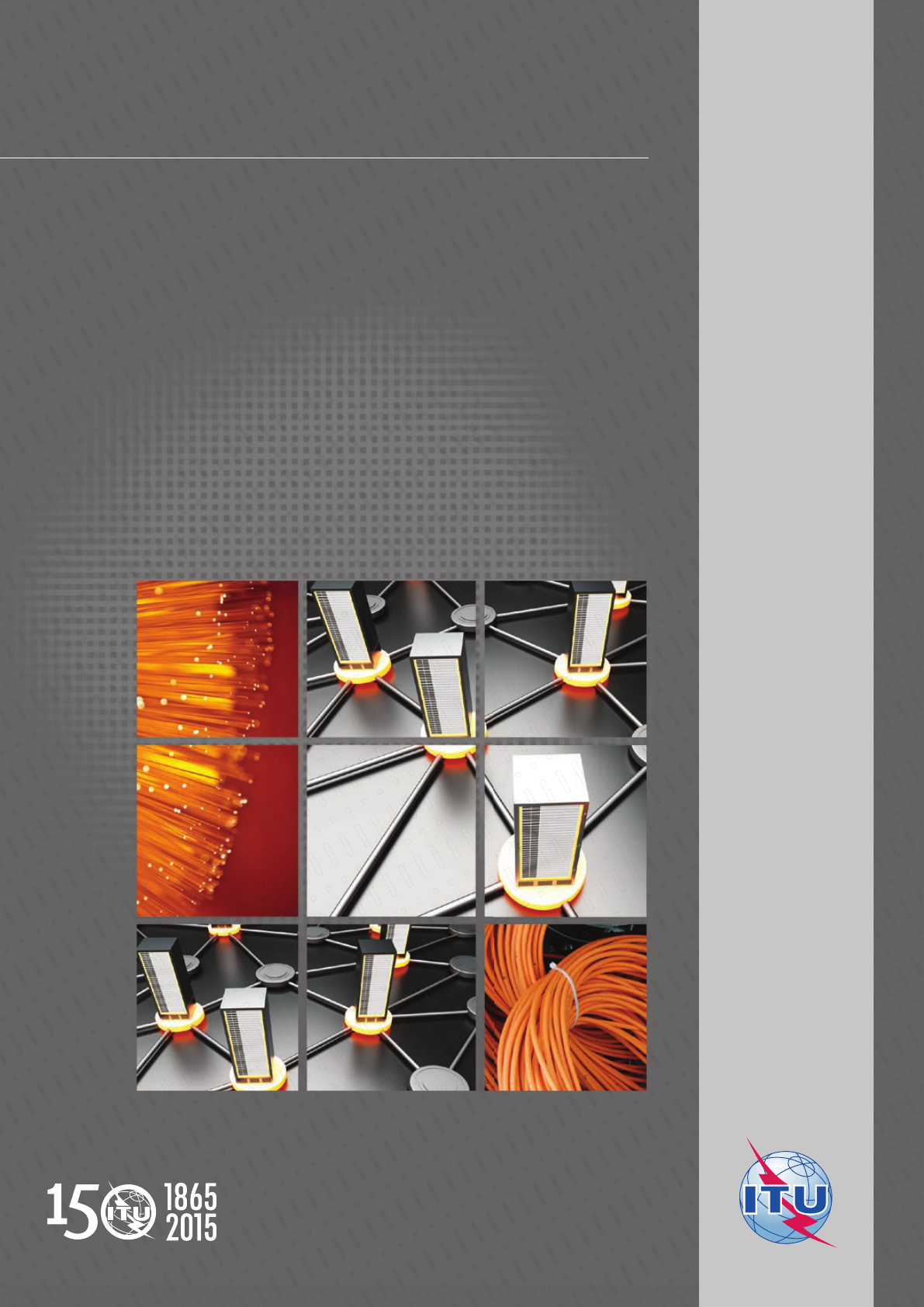
Printed in Switzerland
Geneva, 2015
07/2015
Guidelines for the preparation of a
NATIONAL TABLE OF
FREQUENCY ALLOCATIONS
(NTFA)
INFRASTRUCTURE
International Telecommunication Union
Telecommunication Development Bureau
Place des Nations
CH-1211 Geneva 20
Switzerland
www.itu.int
GUIDELINES FOR THE PREPARATION OF A NATIONAL TABLE OF FREQUENCY ALLOCATIONS (NTFA)
Telecommunication Development Sector
ISBN 978-92-61-15591-9
9 7 8 9 2 6 1 1 5 5 9 1 9
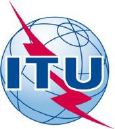
Guidelines for the preparation of a
National Table of Frequency Allocations
(NTFA)

These guidelines focus on the detailed preparation of a National Table of Frequency Allocation (NTFA). In
addition it is providing a brief overview of the essential requirements of the international and national
spectrum framework(s) to assist in the understanding of how an NTFA should operate within these
frameworks. This report was prepared by ITU expert Terence Jeacock, under the supervision of the ITU
Telecommunication Development Bureau (BDT) Spectrum Management and Broadcasting Division and with
the co-operation of the ITU Radiocommunication Bureau (BR).
Please consider the environment before printing this report.
ITU 2015
All rights reserved. No part of this publication may be reproduced, by any means whatsoever, without the
prior written permission of ITU.

Guidelines for the preparation of a National Table of Frequency Allocations (NTFA)
iii
Table of contents
Page
1 Introduction ...................................................................................................................... 1
2 The ITU Radio Regulations ................................................................................................. 2
2.1 General scope ................................................................................................................... 2
2.2 Key definitions .................................................................................................................. 2
2.2.1 Services and stations .............................................................................................. 2
2.2.2 Frequency management ........................................................................................ 3
2.2.3 Other concepts related to spectrum management ............................................... 4
2.2.4 Categories of services and allocations ................................................................... 4
2.2.5 Radio Regulations Regions ..................................................................................... 5
2.2.6 Footnotes to the Table of Frequency Allocations .................................................. 5
2.2.7 Harmonization ....................................................................................................... 5
2.3 Table of Frequency Allocations ......................................................................................... 6
2.4 Radio Regulations and the National Table of Frequency Allocations ............................... 6
3 The International and National Spectrum Management Framework .................................... 7
3.1 Spectrum management levels (of authority) .................................................................... 7
3.1.1 International (worldwide level) ............................................................................. 7
3.1.2 International (regional level) ................................................................................. 8
3.1.3 National (allocation level) ...................................................................................... 8
3.1.4 National (assignment level) ................................................................................... 8
4 The essential requirements for effective national spectrum management ........................... 9
4.1 Legal basis for spectrum management ............................................................................. 9
4.2 Institutional organisation of spectrum management ....................................................... 10
4.3 Consultation with major spectrum stakeholders ............................................................. 10
4.4 National spectrum control and enforcement ................................................................... 10
5 National spectrum planning and the Table of Frequency Allocations ................................... 11
6 National Table of Frequency Allocations: structure ............................................................. 11
7 National frequency use information ................................................................................... 12
7.1 Relevant information ........................................................................................................ 12
7.2 Options for presenting national frequency use information ............................................ 13

Guidelines for the preparation of a National Table of Frequency Allocations (NTFA)
iv
Page
8 Practical steps to develop a NTFA ....................................................................................... 13
9 Publishing the NTFA and national frequency use tables ....................................................... 14
10 Regional co-operation in presenting National Frequency Allocation Tables .......................... 15
Annex 1: List of reference material (relevant to preparation of an NTFA) ....................................... 16
Annex 2: Radio Regulations: Extract form Article 5: Table of Frequency Allocations ....................... 18
Annex 3: NTFA in table format and generic contents ..................................................................... 20
Annex 4: National table of frequency use: Typical information to be included (in annexes) ............ 22
Annex 5: Examples of National Tables of Frequency Allocations ................................................... 29
Annex 6: Examples of national footnotes ..................................................................................... 37
Annex 7: Examples of regional cooperation in Frequency Allocation Tables ................................... 39
Annex 8: Examples of tables of frequency use .............................................................................. 43
Annex 9: Examples of on-line access to frequency allocation and use information ......................... 50
Annex 10: Example of obtaining information on national spectrum use from operators: Nigeria .... 52
Annex 11: List of example administration web sites and URLS to access NTFA ............................... 53
Annex 12: Glossary of Abbreviations ............................................................................................ 54

Guidelines for the preparation of a National Table of Frequency Allocations (NTFA)
1
1 Introduction
In ITU and in other national and international specialized organizations, there have been many studies over
the last few years to demonstrate that the radio spectrum is a major national asset, contributing significant
value to the economy and playing a vital role in social and physical welfare and national security. In all
countries there are many competing demands to use the spectrum for different radio services, from
government, public and private users. In addition, there will be obligations to reserve certain frequency
bands for “international” systems such as maritime and aeronautical services and spectrum demands for
other global or regional terrestrial and satellite telecommunications systems that require a degree of
frequency harmonisation for cross-border interoperability.
It is a government responsibility to develop national spectrum management policies that conform to the
international treaty obligations of the ITU Radio Regulations
1
while meeting national spectrum needs.
Within the national legal framework for telecommunications (including radiocommunications), a spectrum
management organisation usually has the delegated authority to prepare spectrum plans that meet
government policies. In practice, this will involve considerable consultation with spectrum stakeholders,
including government users and major public users or other agencies, to ensure optimal use of the radio
spectrum. National spectrum plans should be reviewed regularly and, when necessary, be updated to keep
pace with technology and changing demands.
One of the most important tools for effective spectrum management is a carefully prepared National Table
of Frequency Allocations (NTFA). This is the outcome of national spectrum planning and will have been
approved at senior government level (e.g. by the Cabinet Office depending on the structure of the
government and power delegated as per the law of the country) and given the appropriate legal authority
to ensure it is implemented and can be enforced.
The NTFA will have several levels of detail. The top level should define clearly how frequency bands have
been allocated in conformity with the Radio Regulations to radiocommunications services in the country
concerned. The next level should define how these “service bands” are divided or shared between major
uses, in particular government (including military and security services) and non-government uses. This is
particularly important when detailed frequency planning or assignment responsibilities are delegated to
different government departments or agencies. Further sub-levels may define specific uses or technical
conditions of use (e.g. channel arrangements).
In the last decade, there have been significant developments in both technological and regulatory
approaches to national spectrum management. Some administrations have been moving away from the
traditional centralised control “administrative approach” to more flexible “market-based” regulation.
However, the NTFA continues to have an essential role whichever approach is taken.
These guidelines focus on the detailed preparation of an NTFA. However, it is necessary to provide a brief
overview of the essential requirements of the international and national spectrum framework(s) to assist
in the understanding of how an NTFA should operate within these frameworks. Annex 1 provides links to
ITU and other resources for the reader to obtain a far more detailed description and assistance in various
aspects of spectrum management.
1
See sections 2.1 : ITU Radio Regulations; further info at: www.itu.int/pub/R-REG

Guidelines for the preparation of a National Table of Frequency Allocations (NTFA)
2
Gestion du spectre
radioélectrique au Niger
2 The ITU Radio Regulations
2.1 General scope
Since radiowaves ignore borders, international coordination of spectrum use is necessary, and the ITU Radio
Regulations (hereinafter the Regulations)
2
is the legal instrument that does this: it determines how the
radio frequency spectrum is shared between different services and how satellite orbits are to be used, and
it prescribes how equipment and systems must operate to ensure peaceful cohabitation, avoiding
interference with each other, in today’s increasingly crowded airwaves.
The Regulations have a binding nature for ITU Member states, and ITU acts as depositary of the Regulations,
which are elaborated and revised by administrations and membership during world radio conferences
(WRCs)
3
(every 3 to 4 years). The most recent version is the Radio Regulations, Edition 2012, as revised
during WRC-12. The majority of the provisions of these Regulations entered into force on 1 January 2013.
The Regulations are compiled in four volumes (and a set of maps), as follows:
• VOLUME 1: Articles (59)
• VOLUME 2: Appendices (22)
• VOLUME 3: Resolutions (151) and Recommendations (24)
• VOLUME 4: ITU-R Recommendations incorporated by reference (39)
• MAPS: Set of Maps for App. 27
The Regulations are complemented by its Rules of Procedure, which, where necessary, explain or clarify the
way in which the provisions of the Regulations are to be applied. These Rules of Procedure are adopted by
the Radio Regulations Board (RRB).
4
The central provision of the Regulations is to enable recognition of
spectrum uses and their protection against harmful interference, at national and international levels.
5
2.2 Key definitions
Before considering the preparation of tables of frequency allocations, it is perhaps necessary to review
some of the terminology used in spectrum management. The complete definitions are given in the
Regulations. The most relevant definitions and a simplified description are given below (numbering
corresponds to that used in the Regulations):
2.2.1 Services and stations
• 1.3 Telecommunication: Any transmission, emission or reception of signs, signals, writings,
images and sounds or intelligence of any nature by wire, radio, optical or other electromagnetic
systems.
2
The legal framework of ITU comprises the basic instruments of the Union, which have treaty status and are binding on
ITU Member States. These instruments are the Constitution and Convention of the International Telecommunication
Union and the Administrative Regulations, which complement the Constitution and the Convention. The Radio
Regulations (RR) form an integral part of the Administrative Regulations: available free of charge (download) at:
www.itu.int/pub/R-REG-RR-2012
3
Further WRC info at: www.itu.int/ITU-R/index.asp?category=conferences&rlink=wrc&lang=en
4
Further information about Rules of Procedure and RRB can be found at: www.itu.int/pub/R-REG. Rules of Procedure are
also available free of charge (download) at: www.itu.int/pub/R-REG-ROP/en
5
Relevant definitions of: interference, permissible interference, accepted interference, and harmful interference are
provided in the Regulations (respectively): 1.166, 1.167, 1.168, 1.169. Unless explicitly indicated otherwise, as in spectrum
management literature generally, the word “interference” shall be interpreted as “harmful interference”.

Guidelines for the preparation of a National Table of Frequency Allocations (NTFA)
3
• 1.5 Radio waves or hertzian waves: Electromagnetic waves of frequencies arbitrarily lower
than 3000 GHz, propagated in space without artificial guide.
• 1.19 Radiocommunication service: A service involving the transmission, emission and/or
reception of radio waves for specific telecommunication purposes.
• 1.61 Station: One or more transmitters or receivers or a combination of transmitters and
receivers, including the accessory equipment, necessary at one location for carrying on a
radiocommunication service, or the radio astronomy service.
The Regulations classify services that use radio communications according to several parameters, namely:
• Link type: Terrestrial (earth to earth) or satellite (earth-satellite, satellite-earth, satellite-satellite);
• Type of coverage: land, maritime, aeronautical;
• Station type: fixed, mobile;
• Type of use: communications, broadcasting, navigation and associated, meteorological, scientific,
earth observation, time standard, astronomy, security, special.
The Regulations also define the different types of radio stations, classified as:
• terrestrial space;
• land, sea, air;
• fixed, mobile;
• broadcasting, amateur radio, radio-astronomy, etc.
The Regulations define 41 types of services and 53 types of stations (more stations than services, as some
stations simultaneously involve several services).
2.2.2 Frequency management
• 1.16 allocation (of a frequency band): Entry in the Table of Frequency Allocations of a given
frequency band for the purpose of its use by one or more terrestrial or space radiocommunication
services or the radio astronomy service under specified conditions. This term shall also be applied
to the frequency band concerned.
• 1.17 allotment (of a radio frequency or radio frequency channel): Entry of a designated frequency
channel in an agreed plan, adopted by a competent conference, for use by one or more
administrations for a terrestrial or space radiocommunication service in one or more identified
countries or geographical areas and under specified conditions.
• 1.18 assignment (of a radio frequency or radio frequency channel): Authorization given by an
administration for a radio station to use a radio frequency or radio frequency channel under
specified conditions.
According to these definitions, it can be concluded that:
• An allocation is then a distribution of frequencies to radio services. An allocation can be made to
a service on either an exclusive or shared basis. If an allocation is shared, the services may be
given primary or secondary status.
• An allotment is an entry of a designated channel in a plan for use by one or more countries in
those countries or within designated areas for a radiocommunication service under specified
conditions. An allotment is then a distribution of frequencies to geographical areas or countries.
• An assignment is an authorization given for a radio station (of a radiocommunication service) to
use a radio frequency or a radio frequency channel under specified conditions. An assignment is
then a distribution of a frequency or frequencies to a given radio station.

Guidelines for the preparation of a National Table of Frequency Allocations (NTFA)
4
Gestion du spectre
radioélectrique au Niger
• Allocations are granted to radiocommunications services, while assignments are granted to the
operator of a radiocommunication station. Any station assignment has to be consistent with the
allocation of the band such station intends to operate.
2.2.3 Other concepts related to spectrum management
Although not explicitly defined in the Regulations, when dealing with band allocations (Article 5), the use in
footnotes of the expressions “identified” and “designated” express the interest/intention of some
administrations on a future use of that band for a specific application that may benefit from a mid- and
long-term harmonization of the use of that band. Examples are:
• Bands identified for International Mobile Telecommunications (IMT), footnotes: 5.286AA,
5.313.A, 5.317A, 5.3: 84A, 5.388, 5.430A. 5432A, 5.432B, 5.433A.
• Bands identified for use by high-density applications in the fixed-satellite service, footnote:
5.516B.
• Bands designated for industrial, scientific and medical (ISM) applications, footnotes: 5.138, 5.150.
• Bands designated for use by high altitude platform stations, footnotes: 5.552A.
As indicated on those footnotes, such designations/identifications in the international Table of Frequency
Allocations do not preclude the use of this band by any application of the services to which it is allocated
and does not establish priority in the Radio Regulations.
However, they are a key element of worldwide or regional spectrum harmonization, and a pre-requisite for
economies of scale and interoperability of equipment and networks, to the benefit of final users, in
particular in case of mass applications. At the time where trade barriers are being gradually suppressed and
mass application terminals are crossing borders without control, following international spectrum
harmonisation is also a good protection against interference arising from non-compliant terminals.
2.2.4 Categories of services and allocations
When the same band is shared between several services, categories are established, such as:
a) Primary services (printed in “capitals” example: FIXED) b) secondary services (with lower case
example: Mobile).
Their privileges and duties are established in the Regulations as:
5.28 3) Stations of a secondary service:
5.29 a) shall not cause harmful interference to stations of primary services to which
frequencies are already assigned or to which frequencies may be assigned at a later
date;
5.30 b) cannot claim protection from harmful interference from stations of a primary
service to which frequencies are already assigned or may be assigned at a later date;
5.31 c) can claim protection, however, from harmful interference from stations of the
same or other secondary service(s) to which frequencies may be assigned at a later date
b) Primary Basis (according to the above definitions): means that in accordance with the nature of
a right granted to the assignee of a particular spectrum (band or spot frequency), the assignee is
the only entity to use the identified spectrum and is entitled to protection from:
i. harmful interference caused by any other spectrum user who may be authorized to use same
spectrum on secondary basis; and
ii. claims of harmful interference by any such spectrum user.
c) Secondary basis: means the nature of a right granted to the assignee of a particular spectrum
(band or spot frequency), is subject to the condition that the entity does not cause any harmful

Guidelines for the preparation of a National Table of Frequency Allocations (NTFA)
5
interference to, or claim protection from any harmful interference caused by, other licensees who
have been granted the right to use same frequency bands on primary or co primary basis.
It should be noted that the primary services protection considers both present and future stations;
therefore regulators need to consider a long term planning of possible assignments nationwide in the
concerned band.
2.2.5 Radio Regulations Regions
Frequency bands are allocated to different services either worldwide (worldwide allocation) or regionally
(regional allocation). To this end, the world is divided into three Regions (Regions 1, 2, 3), defined in the
Radio Regulations (No. 5.2). In the allocations Table, there is a column for each regional allocation. The
Regulations Regions are depicted in Figure 1.
Figure 1: the Radio Regulations three Regions
Source: ITU
2.2.6 Footnotes to the Table of Frequency Allocations
Exceptions to the regional allocations (additional or alternative allocations, different categories of service,
etc.) or restrictions on allocations in the Table in Section IV of Art. 5 - usually geographical in a smaller area
than the region (country, group of countries) - are covered in "footnotes" to the Table (numbered 5.nnn,
sometimes 5.nnnA, 5.nnnB etc. where an addition has been made by a WRC).
2.2.7 Harmonization
Harmonization (as far as possible) is a key objective of the Regulations, as indicated in Recommendation 34
(REV.WRC-12):
“recommends that future world radiocommunication conferences:
2. should, wherever possible, allocate frequency bands on a worldwide basis (aligned services,
categories of service and frequency band limits) taking into account safety, technical,
operational, economic and other relevant factors;
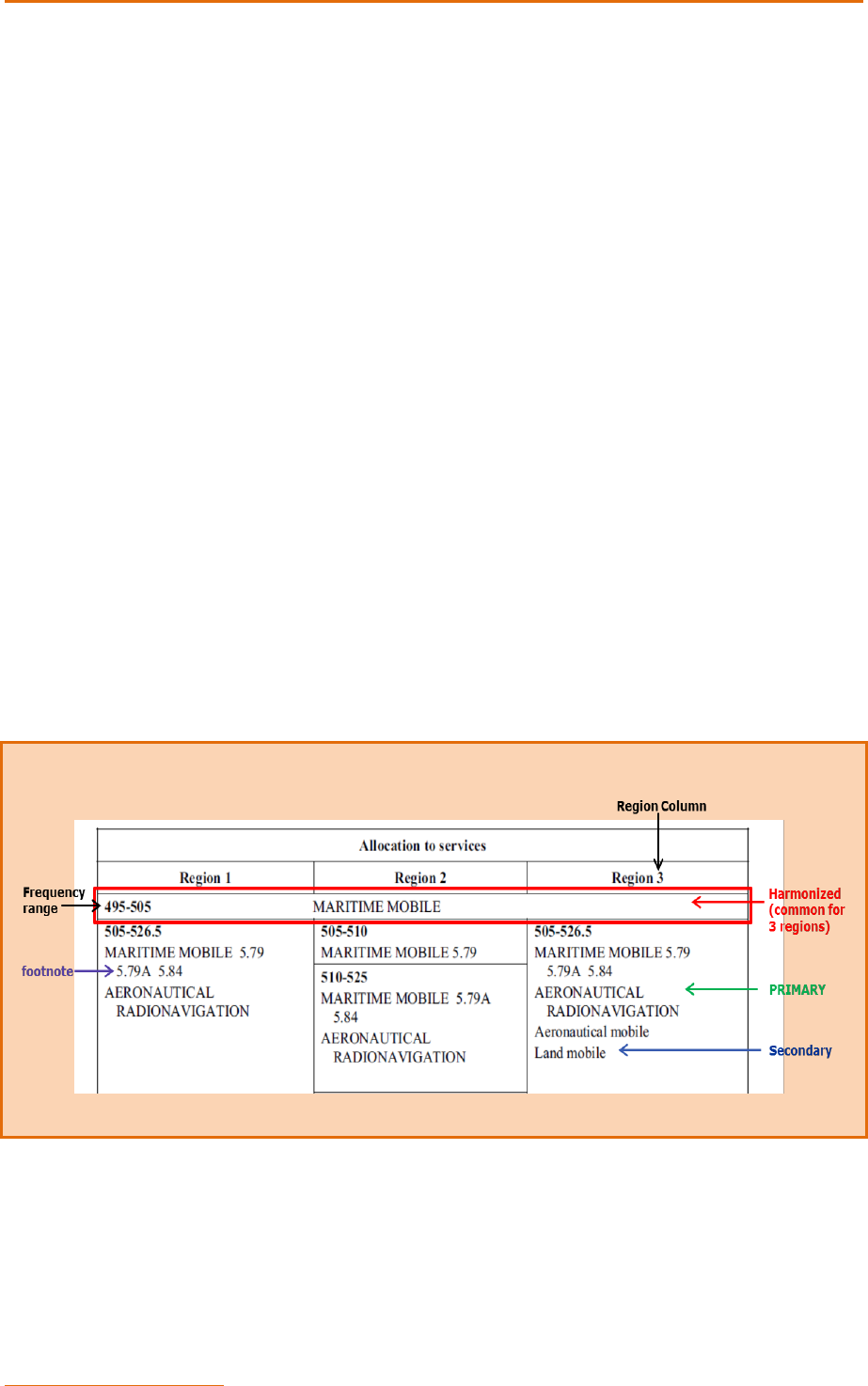
Guidelines for the preparation of a National Table of Frequency Allocations (NTFA)
6
Gestion du spectre
radioélectrique au Niger
3. should, wherever possible, keep the number of footnotes in Article 5 to a minimum when
allocating frequency bands through footnotes, in line with Resolution 26 (Rev.WRC-07);”
2.3 Table of Frequency Allocations
Article 5 of the Radio Regulations contains the (international) Table of Frequency Allocations. The
presentation and the special methods of notation used in this Table enable important information about
the applicability and status of an allocation to be understood at a glance. These features are summarised
below because national allocations should conform to the international Table.
Annex 2 of this report contains an extract from the Table of Frequency Allocations in Article 5 of the Radio
Regulations. It shows that:
• the Table of Frequency Allocations is divided into three columns; one for each ITU Region;
• the Table of Frequency Allocations is divided into rows; one for each frequency band;
• the complete Table shows allocations for the electromagnetic spectrum from 8.3 kHz to 275 GHz;
• the frequency ranges below 8.3 kHz and 275-3000 GHz are shown as “Not allocated”;
• some frequency bands have considerable variation in allocations between Regions, while some
bands have the same allocation in all Regions, i.e. an allocation on a world-wide basis;
• services are denoted as having a primary allocation when printed in capital letters (upper-case)
e.g. FIXED and secondary services are printed as normal letters (lower-case) e.g. Fixed;
• Footnotes to the Table may be used to specify additional or alternative allocations for a frequency
band or to specify technical or operational restrictions on the use of frequency bands, services or
applications.
The excerpt in Figure 2 of the Table of Frequency Allocations in the Radio Regulations illustrates the cases
described above.
Figure 2: Excerpt from the Table of Frequency Allocations in the Radio Regulations
Source: ITU
2.4 Radio Regulations and the National Table of Frequency Allocations
The Radio Regulations is a part the ITU Administrative Regulations that collectively contain provisions that
govern international telecommunications. They complete the provisions of the ITU Constitution and
Convention and are binding on all Member States and therefore the NTFA must be consistent with these

Guidelines for the preparation of a National Table of Frequency Allocations (NTFA)
7
Regulations. However, it also has to respond to national interests and needs in relation to spectrum usage.
Some relevant considerations in this regard are as follows:
• Inclusion of Footnotes of the Regulations: NTFA might contain a different allocation than those
in the allocations table (Art. 5) basically: a) additional allocation (adding more services); b)
different (alternative) allocations (allocating to other different services instead); c) change
categories to allocated services (different categories).
As these differences were accepted by the competent WRCs and included in the Regulations, they
enjoy international recognition (with the limitations contained in the respective footnote).
• Choice of allocations: In most frequency bands, the Regulations leave the flexibility to each
country to exercise a choice between several allocations. Often, this choice has to be exercised
because the corresponding services would be incompatible over the same territory (e.g.
broadcasting and mobile IMT). Alternatively, the NFTA may split the band into sub-bands, each
allocated to one or more of those services already allocated in the Regulations.
• Worldwide and regional harmonization: In order to benefit from economies of scale,
interoperability and facilitate equipment compliance, worldwide and regional harmonisations
need to be followed, wherever possible. In this regard, the NTFA should also include details on
which a particular standard or detailed “Band Plan” (or channel plan) is applicable in the country
for a given allocation, consistent with this harmonisation. This information may be included in
Annexes to the NTFA.
• Technology neutrality: In order to keep flexibility in adopting new and more efficient
technologies, it is preferable to avoid mandating specific technologies for the use of a specific
allocation.
3 The International and National Spectrum Management Framework
3.1 Spectrum management levels (of authority)
The radio frequency spectrum is managed on a number of levels:
• International: At a worldwide level by Member States of the International Telecommunication
Union (ITU); and, in most cases, at a regional level, by regional organizations
6
, which act
consistently within the ITU framework (note that in this context, “region” is not directly
equivalent to ITU Regions defined above).
• National at the allocation level by the administration of the Member State; and at the
assignment level by delegated agencies, service providers, operators, users.
3.1.1 International (worldwide level)
The international framework for the use of the radio frequency spectrum is set out in a treaty – the Radio
Regulations – ratified by the Member States of the International Telecommunication Union (ITU), a
specialized UN agency. The Radio Regulations govern the use of the radio-frequency spectrum and the
geostationary satellite and non-geostationary-satellite orbits. Article 5 of the Radio Regulations deals with
regulations for frequency allocation and contains the (international) Table of Frequency Allocations,
together with various definitions concerning frequency allocation. The Table of Frequency Allocations
reflects decisions made on the purpose or purposes to which particular frequencies will be put.
World radiocommunication conferences (WRC) are held every three to four years. It is the job of WRC to
review, and, if necessary, revise the Radio Regulations, the international treaty governing the use of the
6
A list of Regional Telecommunication Organisations is given at www.itu.int/council/regorg.html

Guidelines for the preparation of a National Table of Frequency Allocations (NTFA)
8
Gestion du spectre
radioélectrique au Niger
radio-frequency spectrum and the geostationary-satellite and non-geostationary-satellite orbits. Revisions
are made on the basis of an agenda determined by the ITU Council, which takes into account
recommendations made by previous world radiocommunication conferences.
The general scope of the agenda of world radiocommunication conferences is established four to eight
years in advance, with the final agenda set by the ITU Council two years before the conference, with the
concurrence of a majority of Member States.
Under the terms of the ITU Constitution, a WRC can:
• revise the Radio Regulations and any associated frequency assignment and allotment plans;
• address any radiocommunication matter of a worldwide character;
• instruct the Radio Regulations Board and the Radiocommunication Bureau, and review their
activities;
• determine Questions for study by the Radiocommunication Assembly and its Study Groups in
preparation for future Radiocommunication Conferences.
3.1.2 International (regional level)
Regional Telecommunication Organizations have been established (usually) by administrations to develop
harmonization measures intended to facilitate free movement of telecommunication equipment and
services within the region and to offer industry and operators the economies of scale through a larger
market with common requirements. Harmonisation measures may include harmonization of frequency use,
common technical requirements and preparation of common proposals to ITU world radio conferences. A
detailed description of regional harmonization and regional organizations is given in ITU-R Report SM.2093.
3.1.3 National (allocation level)
A national legislative framework must be in place to establish an administration recognised by ITU as
responsible for discharging the obligations undertaken in the Constitution of the International
Telecommunication Union, in the Convention of the International Telecommunication Union and in the
Administrative Regulations (CS 1002). These obligations include management of the radio spectrum. The
administration may be a government ministry, or an independent regulator operating under a legislative
mandate or policy guidelines.
An essential part of this legislative framework will be for the administration to establish a National Table of
Frequency Allocations that sets out the radio services that can be used, which frequency bands, and under
what conditions. The NTFA should be based on the Table of Frequency Allocations in Article 5 of the Radio
Regulations. Section 6 of this report shows how to extend the Table of Frequency Allocations in Article 5 of
the Radio Regulations into a National Table and Section 8 suggests typical methods for organising NTFA
development. It is good practice to develop a national allocation chart for easy reference of all stake
holders.
Over time, in all countries, changes in technology and user needs will require changes to the NTFA. If it is
not possible to accommodate these changes in conformity with the allocations of the current International
Table, it will be necessary for the administration to seek changes to the International Table at a World Radio
Conference. In practice, it is normal for administrations to co-operate with other (neighbouring and/or
regional) administrations in WRC preparations at regional and global (ITU) levels to enable their changing
requirements to be co-ordinated and developed in an organised framework. With the current pace of
technology development, this is an on-going task and the administration will establish national consultative
procedures to prepare national requirements and positions for presentation at regional preparation
meetings and radiocommunication conferences.
3.1.4 National (assignment level)
Assigning a particular frequency (or groups of frequencies) to users (stations) is the detailed level of national
spectrum management. The methods used may be administrative, market-based or some spectrum may

Guidelines for the preparation of a National Table of Frequency Allocations (NTFA)
9
be reserved for licence-exempt
7
use that satisfies certain technical or operational conditions, for example
restricted power levels and geographic range. For licensed use, this detailed level usually includes
establishing policies for technical conditions for frequency use. Conditions of use may vary widely, from
reserving particular frequencies for specific uses with detailed technical requirements (for example:
channel plans, equipment standards and assignment criteria), to allowing considerable flexibility in
spectrum use for particular bands or services with light technical requirements (e.g. a simple spectrum
mask). This information on detailed frequency use can be published either as part of the NTFA (e.g. in
referenced annexes to the NTFA) or as a separate National Table of Frequency Use.
4 The essential requirements for effective national spectrum
management
4.1 Legal basis for spectrum management
The foundation of effective spectrum management is to ensure that the legal basis for the regulation of the
spectrum is set out in legislation and detailed in regulations made pursuant to the legislation. Legislation
should set out such things as definitions, powers of the Minister or head of the spectrum regulatory
authority, the powers of others involved in spectrum regulation, offences and penalties and the
organizational structure and framework for regulation of the spectrum.
In addition to the legislation and regulations, there may be other publications issued by the spectrum
regulator that provide guidance to a specific group or groups of users of the spectrum.
Something to consider when establishing the legal framework is the use of incorporation by reference. Since
legislation or even regulations are usually not frequently amended, often incorporation by reference is used
to give legal effect to subservient text or documents. Under incorporation by reference, texts in one
document having a certain legal status, such as the legislation or regulations, may cite other documents
that normally would not have the same legal status and, depending on the nature of such reference,
incorporation may confer the same legal status on these other documents. For example, regulations may
state that a certain standard, perhaps developed by an international body, shall apply in a given situation.
Such incorporation by reference of texts can be of two types: static incorporation or dynamic incorporation.
In the former, a specific document issued at a specific date is referred to in the legal text. In the case of
dynamic incorporation by reference, the reference in the legal text is to a specific document but with a
phrase like “as amended from time to time”, which allows for changes without going through the entire
legislation or regulation approval process.
In order to preserve clarity and authority in rule-making, the scope of such delegation should be clearly
defined. Legislation and/or regulations must make clear who has authority to designate changing sources
of external reference when these are not already specified in existing regulation. Such delegation should
be set out in a delegation instrument approved by that institution. The development of legislation and
regulations and all subservient documentation should be developed in a transparent way with full
consultation of spectrum users.
7
It should be noted that Article 18 (18.1.1) of the Regulations mandates that: “No transmitting station may be established
or operated by a private person or by any enterprise without a licence issued in an appropriate form and in conformity
with the provisions of these Regulations by or on behalf of the government of the country to which the station in question
is subject”. Hence, “licence-exempt” and similar expressions (e.g. “unlicensed”, etc.), refers to radio devices with
transmitting capabilities (emitting radio waves) that can be operated by any person, without previously obtaining a
particular authorization for it (particular licence).
This particular licensing waiving is only possible because of operation of such devices has been previously authorized to
all public through a Generic Use Authorization (GUA), also named General Licence, or equivalent names. GUA always
includes a set of detailed technical and operational specifications that must be strictly obeyed when operating such
devices, in order to guarantee they can be used with a very low risk of causing interference to other similar devices or
other services. Then, when a NTFA includes these licence exemptions, the pertinent GUA (or equivalent) should also be
included or referenced.

Guidelines for the preparation of a National Table of Frequency Allocations (NTFA)
10
Gestion du spectre
radioélectrique au Niger
The primary telecommunication legislation should require and authorise the administration to establish a
National Table of Frequency Allocations. However, some countries do not include the NTFA itself in the
primary legislation. Provided the administration has sufficient enforcement powers, the NTFA can be
implemented in practice through licensing and agreement with the other government departments. This
gives the administrator or regulator the flexibility to revise the NTFA, when required and subject to
consultation, without delays caused by the processes required to change primary legislation.
4.2 Institutional organisation of spectrum management
As described above, the legislation will establish the national authority for spectrum management. In turn,
this will depend on overall government policy on national regulatory arrangements. For example, the
authority might be a government ministry or an independent regulator; the ministry might be responsible
for policy decisions and the regulator for executive matters; often, there are separate authorities for
government and non-government radio use.
Whichever organisational option is used, there should be a single organisation with the overall authority to
represent the country as the administration at ITU.
However, even if this organisation has also been given sole authority for all national allocation and
assignment, a senior level (i.e. cabinet office) committee should be established to consider and agree major
national spectrum allocation strategy and policy issues with the aim of achieving a rational balance between
government and non-government use. At the very least, all government spectrum users should be
represented at this committee. For example, typical government ministry stakeholders might be:
telecommunications, defence, transport, media (broadcasting). Such a policy and strategy committee
would probably be chaired by telecommunications, or possibly jointly chaired with defence. In the case
where an independent telecommunication regulator has been established, telecommunications might be
represented directly by the ministry or be delegated to the regulator.
4.3 Consultation with major spectrum stakeholders
Consultation with stakeholders is essential in virtually every aspect of spectrum management including the
development of national legislation and regulations, spectrum policies, technical standards, etc. The type
and extent of consultation will depend on government policy and how the institutional authority for
spectrum management has been organised. At the working committees described above, it would be
normal to include major non-government spectrum stakeholders (e.g. service providers, telecom industry,
broadcasting organisations).
While it is seldom practical to consult with each individual spectrum user, effective consultations can take
place by also allowing associations or bodies representing groups of users to contribute. In order to facilitate
consultation on important spectrum management issues, it is important that the spectrum regulator
proposals be made public. In some countries, this is required under broader national legislation governing
all regulatory activities, perhaps by a requirement for setting out proposals in an official or widely-
distributed publication and/or increasingly by using the Internet and official web pages. Sometimes, several
options are presented for public comment. It may also be helpful to allow for exchanges between interested
parties. Often, meetings are held between the spectrum regulator and relevant stakeholders and the
Internet has increasingly become a standard tool for such consultations. Regardless of the means for
obtaining input, minimal guidelines allowing interested parties to contribute should be set, such as allowing
for a given period of time, with a deadline by which comments must be submitted. In all consultations,
transparency and fairness are paramount.
4.4 National spectrum control and enforcement
National laws and regulations are useless unless the administration has the legal power and practical means
to monitor whether spectrum use is in accordance with those laws and regulations and to take effective
action against violations. Some form of national spectrum monitoring capability is therefore required to

Guidelines for the preparation of a National Table of Frequency Allocations (NTFA)
11
undertake regular monitoring campaigns to obtain information on spectrum use and gather evidence of
illegal activity to support subsequent legal action against offenders. The illegal activity can take the form of
unlicensed transmissions or operation that does not conform to the conditions of a licence. Such activity
can cause serious disruption to official and commercial national communications. In addition, the
administration has an obligation to ensure all emissions from its territory conform to the Radio Regulations
and do not cause harmful interference to services, operated in accordance with the Regulations, by other
countries. Administrations are encouraged to examine the regular reports from the International
Monitoring System to check whether any stations operated from their territory have been reported. Annex
1 contains several references to ITU publications to assist in developing a monitoring capability to assist
spectrum management.
5 National spectrum planning and the Table of Frequency Allocations
National spectrum planning should be one of the duties of the spectrum policy and strategy committee,
including setting up regular reviews, in particular as part of the preparations for ITU radio conferences. It
should be emphasized here that there is a direct relationship between effective planning of the spectrum
resource through the continuous review of NTFAs and the economic impact of national spectrum use
through an effective and efficient spectrum allocation consistent with international spectrum
harmonization.
The NTFA is the published outcome of national spectrum planning. Therefore the national spectrum policy
objectives embedded in the NTFA should not only ensure technical compatibility but also provide the
legal/regulatory basis for maximizing economic output from the utilization of the spectrum resource in the
particular context of the corresponding country. Market implications, closer alignment with trading partners
and cost efficiencies are all relevant economic aspects in direct relationship with a well planned NTFA.
The spectrum policy and strategy committee should provide broad policy and strategy guidelines for the
development of the NTFA taking into account technical and economic objectives. The administration
(ministry or regulator) should then take the lead in preparing a draft for committee consideration and
agreement. The regulator would normal establish working groups to undertake the detailed technical and
regulatory work and provide the expertise in frequency assignment, spectrum engineering, monitoring and
standardisation. Representatives from relevant government departments would automatically be working
group members to provide detailed advice on government spectrum use and requirements. It is also
beneficial to invite experts and practitioners from major non-government spectrum stakeholders to
participate.
The NTFA will take the international Table of Frequency Allocations as the source document and work
through each frequency band to decide which service allocations are required nationally and, in the case
where there is more than one organisation responsible for frequency assignments (for example
government and non-government use), decide how frequency bands (or parts of frequency bands) should
be shared between the organisations concerned.
Some flexibility is possible with national allocations while maintaining conformity with the Radio
Regulations. For example, only those international footnotes relevant to the country need to be applied as
national footnotes. Also, in cases where, in the Regulations, a frequency band is allocated to several
services, an administration may select which of those services may operate in its territory (choosing one or
several) or may decide to split the band into sub-bands, each allocated to one or more services allocated in
the Regulations.
6 National Table of Frequency Allocations: structure
A National Table of Frequency Allocations is a method for presenting the national spectrum plan in an easily
understandable (tabular) format. As the NTFA is derived from the international Table of Frequency
Allocations (Article 5 of the Regulations), the same tabular structure is used as it may easily be adapted to
show national allocations, simply by inserting additional columns.

Guidelines for the preparation of a National Table of Frequency Allocations (NTFA)
12
Gestion du spectre
radioélectrique au Niger
A generic example is shown in Annex A3.1. The first three columns are copied from the Radio Regulations
and show the allocations for the three ITU Regions. The order of the region columns could be changed, so
the pertinent regional column may be seen beside the national columns, thereby easing comparisons. Two
columns are added to show national spectrum use. The first national column shows the frequency band
and national service allocation. The second column “Use” shows which national organisations have
assignment responsibility for each sub-band by letter codes: G = Government; NG = Non-Government; P =
shared between G and NG.
Some flexibility is possible with national allocations while maintaining conformity with the Radio
Regulations. In this example, only those international footnotes relevant to the country are listed in the
national footnote column. In cases where a band is allocated to several services, an administration may
select which of those services may operate in its territory. This flexibility is shown in the generic example.
However, for frequency co-ordination, the country must co-ordinate with other countries on the basis of
the Regulations allocations unless bi- or multilateral agreement exists.
In order to provide a complete explanatory framework for their National Table of Frequency Allocations,
most countries include considerably more information; a generic example is shown in Annex A3.2. The
different chapters provide explanatory and definition texts and are usually copied from the Radio
Regulations (RR) as the majority of national users are unlikely to have a copy of the Regulations. Additional
annexes may also be used to provide detailed information on national frequency use and limitations as
described in Section 7 below.
7 National frequency use information
7.1 Relevant information
As explained above, the NTFA provides a general plan for spectrum use at the national service allocation
level. Considerably more detailed planning is required at the national assignment level and this can be
provided by a National Table of Frequency Use as a separate companion to, or as part of, the NTFA. The
amount of and type of information included is optional and depends on the resources of the administration
to compile the information. Country examples are given in Annexes A8.1 to A8.5. The main categories of
information provided are:
• Detailed information about the assignment of frequencies or blocks of frequencies to different
types of system (channelling plans), application or major use. However, assignments to individual
stations are not normally shown. (NTFA and spectrum user databases are different but
complementary. Examples are given in Annex A4.2).
• Technical conditions for frequency access, for example: channel arrangements, bandwidths,
transmitter power limits and equipment standards. Examples are given in Annex A4.3.
• Licensing conditions for frequency access. (Examples of national band sharing arrangements are
given in Annex A4.4 and cross-border frequency co-ordination in Annex A4.5.
• Future re-allocations (repurposing): as a result of long-term planning, decisions taken related to
future changes of services allocations in some bands shall be duly indicated in the NTFA, with
relevant information such as:
- assignment freezing: warning that no new licences will be granted to stations intended to
provide current service(s) and relevant conditions (dates, areas, etc.);
- reallocation roadmap: indicating the intended new service(s) and relevant conditions (dates,
areas, etc.).
These national particularities could be indicated through footnotes in the national allocation column
(with different nomenclature than that used for the Regulations footnotes, to avoid confusion); in those

Guidelines for the preparation of a National Table of Frequency Allocations (NTFA)
13
footnotes, the necessary links can be established with pertinent NTFA annexes (e.g. band plans and
associated roadmaps, retained applications and/or technologies, repurposing roadmaps, etc.)
With an appropriate software tool, it would be possible for the NFTA to depict the present situation
and proposals for future years, considering the above mentioned national particularities.
7.2 Options for presenting national frequency use information
There are different options for presenting and publishing national frequency use information. Some
administrations publish the information in a separate table. Most of the country examples examined in the
preparation of these guidelines provide the information as detailed national footnotes or annexes to the
NTFA that may be referenced in additional columns.
The basic NTFA will have columns with the frequency range, the ITU regional international allocation, the
national allocation, the type of service and the regional harmonized conditions where applicable. In
addition to this basic information, it is becoming very important also to include information that is not only
useful nationally but also internationally. This is due to the fact that ICT equipment makers and commercial
providers often consult the NTFAs in order to ensure that equipment will be compliant with national
requirements.
Therefore, some countries have added, in addition to the basic fields of the NTFA, two (or more) relevant
fields: “Summary of use”, which explains the types of devices normally deployed in a band; and “References
to national policies”, which provides direct reference to the relevant regulatory prescriptions (e.g. Licence
Exempt details, worldwide or regional compliance standards and national prescriptions). This information
is extremely useful in lowering compliance costs and avoiding wrongful import of incompatible wireless
devices. In addition to this more expanded NTFA use, it is also a positive addition to link the NTFA to
published documents on the details of use of each type of service and the bands they operate in, such as
fixed services bands, mobile services bands, broadcasting bands, general user bands, etc. All this provides
extensive benefits from the work put into NTFAs.
8 Practical steps to develop a NTFA
An NTFA is a tabular representation (in frequency order) of a previously developed plan for national
spectrum and frequency use. Most of the examples of NTFAs shown in the annex are from countries with
well-developed national plans. However, there are countries that are in the preliminary stages of
introducing spectrum management and are starting with no spectrum plan. In this case, a “skeleton” NTFA
can provide a helpful map to enable a logical approach to deciding how to allocate spectrum to services to
meet national requirements. An example procedure would be as follows:
a) Using the international allocation table, construct a draft national table by selecting the allocation
“column” for the Region concerned as the base.
b) Identify and add all footnotes relevant for the Region and country concerned.
c) Identify and “reserve” in the draft table the frequency bands used by all major “international”
services, systems or applications which are already in use or are likely to be used in the country:
• international services for maritime and aeronautical;
• public mobile communications systems;
• broadcasting (especially if there is an ITU regional allotment plan);
• fixed services – use ITU-R recommended frequency arrangements;
• non-public mobile systems - unfortunately there are no ITU recommended channel
arrangements, so it will be necessary to consider examples from other countries in the Region
concerned and adopt the most common and comprehensive plans;
• fixed and mobile satellite bands, (especially if there is an allotment plan);

Guidelines for the preparation of a National Table of Frequency Allocations (NTFA)
14
Gestion du spectre
radioélectrique au Niger
• public protection and disaster relief radiocommunication systems (see Recommendation ITU-
R M.2015).
d) Identify and reserve in the draft national table all allocations that would be difficult to use without
causing interference to (or receiving interference from) services in other countries operating in
accordance with the Radio Regulations, even though such services might not be used in the
country concerned:
• primary amateur radio allocations;
• radio astronomy (especially frequency bands where all emissions are prohibited);
• frequencies used for industrial scientific and medical applications;
• frequencies used for short-range devices. See ITU-R Recommendation SM.1896: Frequency
ranges for global or regional harmonization of short-range devices (SRDs).
e) Collect information on existing national frequency use. Potential sources: existing licensing and
assignment records; request users to provide information from their own records; spectrum
monitoring. Potential problems:
• records destroyed or no records kept;
• inadequate records – critical information missing (frequencies, transmitter location);
• users (especially government users) might be reluctant to hand over information for security;
• insufficient resources (personnel, equipment) to monitor spectrum in large country.
Annex 10 contains an actual example of a national exercise to collect spectrum usage information to
improve spectrum management by requesting existing users to complete a “template” specifying details of
use.
f) When existing national use is added to the Table, it is most likely that some will not conform to
the Radio Regulations or will be using frequencies within frequency bands identified for the
services and applications listed above. A transition plan should be prepared for the migration of
non-conforming use to the new plan.
g) If some form of monitoring capability is available, especially mobile monitoring, it may be used to
verify existing records of spectrum use. Where records are poor or non-existent, monitoring can
be used to determine actual frequency use, including finding transmitter locations and control
points by direction finding. Annex 1 provides several links to ITU resources for information on
monitoring equipment, procedures and practices.
9 Publishing the NTFA and national frequency use tables
Some years ago, a National Table of Frequency Allocations would have been considered a confidential
government record and not suitable for public information. With increasing global telecommunications and
liberalization of telecommunication markets, it has become a necessity to publish the information as an aid
to investment and market planning. An Internet search for “National Frequency Allocation Table”, or a visit
to the web site of most administrations shows that the majority of administrations publish their tables in a
fairly standard format that can be downloaded. Electronic publication is more convenient and cost effective
both for administration and user than, for example, a paper version.
Annex 5 contains, in its sub-Annexes, actual examples of published NTFA and Annex 6 contains actual
examples of published national footnotes. All of these examples were obtained from administration web
sites.
Given the usefulness and flexibility provided by software applications, implementing searchable on-line
NTFAs is becoming a need for administrations wanting to provide the public with:
a) a public electronic record that is readily available and with timely updating;

Guidelines for the preparation of a National Table of Frequency Allocations (NTFA)
15
b) a tool for identifying and flagging future modifications to the NTFA, for newly-planned bands
and/or services;
c) clear information about the actual use versus allocation of any particular band (in cases of public
safety, defense and other restricted government use, these can be simply labelled as
“government use” for example);
d) a source of on-line information that can be used to generate important statistics/analytics on
spectrum use.
Annex 9 has examples of administration on-line frequency information and e-licensing systems.
Annex 11 has a list of websites and URLs to access many on-line or downloadable NTFAs. These URLs are
correct at the time these guidelines were produced.
Annex A5.7 contains an example of the national frequency allocation chart facility in the ITU Spectrum
Management System for Developing Countries (SMS4DC
8
). This demonstrates how a National Table of
Frequency Allocations can be integrated into the national spectrum management system. Once it has been
programmed with the NTFA (including national footnotes e.g. information on channel arrangements
applicable to each frequency band), it provides a comprehensive reference facility for frequency assignment
staff using SMS4DC.
10 Regional co-operation in presenting National Frequency Allocation
Tables
There is considerable regional co-operation and harmonization in spectrum management. This has resulted
in regional telecommunications organizations providing “one-stop-shop” frequency allocation and use
information systems. A detailed description of regional harmonization and regional organizations is given
in ITU-R Report SM.2093. Examples are given in Annex 7.
8
See: www.itu.int/pub/D-STG-SPEC

Guidelines for the preparation of a National Table of Frequency Allocations (NTFA)
16
Gestion du spectre
radioélectrique au Niger
Annex 1: List of reference material (relevant to preparation of an NTFA)
ITU-R Study Group 1 (SG1) (www.itu.int/en/ITU-R/study-groups/rsg1/Pages/default.aspx) is directly
involved in Spectrum Management (principles and techniques, general principles of sharing, spectrum
monitoring, long-term strategies for spectrum utilization, economic approaches to national spectrum
management, automated techniques and assistance to developing countries in cooperation with the
Telecommunication Development Sector).
However, certain recommendations from other study groups will assist NTFA preparation e.g.
recommendations on channelling arrangements for the fixed service (see Annex A4.2.9).
ITU-R Recommendations
SM.1050 Tasks of a monitoring service
SM.1139 International monitoring system
SM.1265 National alternative allocation methods
SM.1370 Design guidelines for developing automated spectrum management systems
SM.1392 Essential requirements for a spectrum monitoring system for developing countries
SM.1447 Monitoring of the radio coverage of land mobile networks to verify compliance with a given licence
SM.1537 Automation and integration of spectrum monitoring systems with automated spectrum
management
SM.1603 Spectrum redeployment as a method of national spectrum management
SM.1880 Spectrum occupancy measurement
SM.1896 Frequency ranges for global or regional harmonization of short-range devices (SRDs)
ITU-R Handbooks and Reports
List of ITU Handbooks (see esp. SG01) and download links: www.itu.int/pub/R-HDB
SM.2012: Economic aspects of spectrum management
SM.2015: Methods for determining national long-term strategies for spectrum utilization
SM.2093: Guidance on the regulatory framework for national spectrum management
SM.2153: Technical and operating parameters and spectrum requirements for short-range devices
SM.2255: Technical characteristics, standards and frequency bands of operation for radio-frequency
identification (RFID) and potential harmonization opportunities
Other ITU references
ITU Radio Regulations:
www.itu.int/pub/R-REG-RR/en
ITU International Monitoring System (Reports):
www.itu.int/en/ITU-R/terrestrial/monitoring/Pages/default.aspx
ITU BR Fixed and Mobile Services Department (especially frequency plans)
www.itu.int/en/ITU-R/terrestrial/fmd/Pages/default.aspx
ITU BR Space Services Department

Guidelines for the preparation of a National Table of Frequency Allocations (NTFA)
17
www.itu.int/en/ITU-R/space/Pages/default.aspx
Other reference material
Radio Spectrum Management 2
nd
Edition (Withers)
Publisher: The Institution of Electrical Engineers
ISBN: 0 85296 770 5
Essentials of Modern Spectrum Management (Cave, Doyle, Webb).
Publisher: Cambridge University Press
ISBN: 978-0-521-20849-9

Guidelines for the preparation of a National Table of Frequency Allocations (NTFA)
18
Gestion du spectre
radioélectrique au Niger
Annex 2: Radio Regulations: Extract form Article 5: Table of Frequency
Allocations
Allocation to services
Region 1
Region 2
Region 3
3 230-3 400 FIXED
MOBILE except aeronautical mobile
BROADCASTING 5.113
5.116 5.118
3 400-3 500 AERONAUTICAL MOBILE (R)
3 500-3 800
AMATEUR
FIXED
MOBILE except aeronautical
mobile
3 500-3 750
AMATEUR
5.119
3 500-3 900
AMATEUR
FIXED
MOBILE
5.92
3 750-4 000
3 800-3 900
FIXED
AERONAUTICAL MOBILE (OR)
LAND MOBILE
AMATEUR
FIXED
MOBILE except aeronautical
mobile (R)
3 900-3 950
AERONAUTICAL MOBILE (OR)
5.123
3 900-3 950
AERONAUTICAL MOBILE
BROADCASTING
3 950-4 000
FIXED
BROADCASTING
3 950-4 000
FIXED
BROADCASTING
5.122 5.125
5.126
4 000-4 063 FIXED
MARITIME MOBILE 5.127
5.126
4 063-4 438 MARITIME MOBILE 5.79A 5.109 5.110 5.130 5.131 5.132
5.128
4 438-4 488
FIXED
MOBILE except aeronautical mobile
(R)
Radiolocation 5.132A
4 438-4 488
FIXED
MOBILE except aeronautical mobile
(R)
RADIOLOCATION 5.132A
4 438-4 488
FIXED
MOBILE except aeronautical mobile
Radiolocation 5.132A
5.132B
4 488-4 650
FIXED
MOBILE except aeronautical mobile (R)
4 488-4 650
FIXED
MOBILE except aeronautical mobile
4 650-4 700 AERONAUTICAL MOBILE (R)
4 700-4 750 AERONAUTICAL MOBILE (OR)
4 750-4 850
FIXED
AERONAUTICAL MOBILE (OR)
LAND MOBILE
BROADCASTING 5.113
4 750-4 850
FIXED
MOBILE except aeronautical mobile
(R)
BROADCASTING 5.113
4 750-4 850
FIXED
BROADCASTING 5.113
Land mobile
4 850-4 995 FIXED
LAND MOBILE
BROADCASTING 5.113
4 995-5 003 STANDARD FREQUENCY AND TIME SIGNAL (5 000 kHz)

Guidelines for the preparation of a National Table of Frequency Allocations (NTFA)
19
The following presentational features and conventions should be noted:
ITU Regions (See Regulations 5.2 to 5.9): The Table is divided into three columns to show different
allocations in the three ITU Regions [probably need to include the Region map]
Categories of services (See Regulations 5.23-5.31): Radiocommunication services printed in “capitals”
(example: FIXED); these are called “primary” services); services the names of which are printed in “normal
characters” (example: Mobile); these are called “secondary” services.
Categories of allocations (See Regulations 5.32-5.44): Footnotes to the Table are used to specify different
category of service, additional allocations, alternative allocations and miscellaneous provisions. Examples:
5.133 Different category of service: in Armenia, Azerbaijan, Belarus, the Russian Federation, Georgia,
Kazakhstan, Latvia, Lithuania, Niger, Uzbekistan, Kyrgyzstan, Tajikistan, Turkmenistan and Ukraine, the
allocation of the band 5 130-5 250 kHz to the mobile, except aeronautical mobile, service is on a primary
basis (see No. 5.33). (WRC-12)
5.125 Additional allocation: in Greenland, the band 3 950-4 000 kHz is also allocated to the broadcasting
service on a primary basis. The power of the broadcasting stations operating in this band shall not exceed
that necessary for a national service and shall in no case exceed 5 kW.
5.132B Alternative allocation: in Armenia, Austria, Belarus, Moldova, Uzbekistan and Kyrgyzstan, the
frequency band 4 438-4 488 kHz is allocated to the fixed and mobile, except aeronautical mobile (R),
services on a primary basis. (WRC-12)
5.132 The frequencies 4 210 kHz, 6 314 kHz, 8 416.5 kHz, 12 579 kHz, 16 806.5 kHz, 19 680.5 kHz, 22 376 kHz
and 26 100.5 kHz are the international frequencies for the transmission of maritime safety information
(MSI) (see Appendix 17).

Guidelines for the preparation of a National Table of Frequency Allocations (NTFA)
20
Gestion du spectre
radioélectrique au Niger
Annex 3: NTFA in table format and generic contents
A3.1: Generic presentation of an NTFA in table format
kHz
Allocation to Services
National Allocation
Region 1
Region 2
Region 3
Frequency and
Service
Use
4 063-4 438
MARITIME MOBILE 5.79A 5.109 5.110 5.130 5.131 5.132
5.128
4063-4438
Maritime Mobile
5.79A 5.109 5.110
5.130 5.131 5.132
G
4 438-4 488
FIXED
MOBILE except
æronautical
mobile (R)
Radiolocation
5.132A
4 438-4 488
FIXED
MOBILE except
æronautical
mobile (R)
RADIOLOCATION
5.132A
4 438-4 488
FIXED
MOBILE except
æronautical
mobile
Radiolocation
5.132A
4 438-4 450
FIXED
G
4 450-4 460
MOBILE except
æronautical
Mobile
NG
4 460-4 488
Mobile except
æronautical
Mobile
RADIOLOCATION
5.132A
S
(Mobile NG)
(Radiolocation G)
The Region 2 (imaginary) country example above demonstrates some flexibility for national allocations in
accordance the Radio Regulations and national distribution of bands between government and non-
government use.
• In the band 4 063-4 438 kHz: Footnote 5.128 is not applicable to the country and has been omitted
in the national table; a Government (G) department is responsible for management.
• The band 4 438-4 488 kHz has been split into 3 sub-bands 4 438-4 450 kHz for Government FIXED
services; 4 450-4 460 kHz for Non-Government MOBILE services; 4 460-4 488 shared between
Government RADIOLOCATION services and Non-Government Mobile services with secondary
national status. Note: the country must accept international co-ordination in accordance with the
international table

Guidelines for the preparation of a National Table of Frequency Allocations (NTFA)
21
A3.2: Generic contents of a National Table of Frequency Allocations
NTFA
Radio Regulations
Chapter 1
I. Meaning of abbreviations
II. Terms and definition
Section I. General terms
1.2 - 1.15
Section II. Frequency management
1.16 - 1.18
Section III. Radiocommunication services
1.19 - 1.60
Section IV. Radio stations and systems
1.61 - 1.115
Section V. Operational terms
1.116 - 1.136
Section VI. Characteristics of emissions and radio
equipment
1.137 - 1.165
Section VII. Frequency sharing
1.166 - 1.176
Section VIII. Technical terms relating to space
1.177 - 1.191
Chapter 2
Frequency bands
2.1 - 2.2
Chapter 3
Technical characteristics of stations
3.1 - 3.14
Chapter 4
Assignment and use of frequencies
Section I. General rules for assignment and use of
frequencies
4.1 - 4.9
Chapter 5
Frequency allocations
5.1
Section I. Regions and areas
5.2 - 5.9
Section II. Categories of services and allocations
5.23 - 5.44
Section III. Footnotes of the Radio Regulations
5.53 - 5.565
Section IV. Plan of Frequency Bands Allocations in the
[Country] (National Frequency Table)
National footnotes and general
information
Section V. National Frequency Table
Annexes
Examples of annexes are given in Annex 4

Guidelines for the preparation of a National Table of Frequency Allocations (NTFA)
22
Gestion du spectre
radioélectrique au Niger
Annex 4: National table of frequency use: Typical information to be included
(in annexes)
A4.1 The information about detailed frequency use, as described in paragraphs 4.2 – 4.4 below should be
contained in annexes to the national table of frequency use, with appropriate references given in the
Table. Examples of national table of frequency use and annexes are given in Annex 8.
A4.2 Identified frequency bands for typical systems and applications
Paragraphs 4.2.1 – 4.2.12 provide guidelines to identify major types of spectrum use and the frequency
bands allocated or designated internationally.
A4.2.1 Identification of Government and Non-Government frequency bands
Frequency bands should be identified as either Government, Non-Government or shared (between
government and non-government services and systems) . Where appropriate and within national security
requirements, it may be helpful and informative to describe further the general type of government use
e.g. defence, emergency services, etc.
A4.2.2 Identification of bands used by aeronautical services
Certain bands are allocated in the Radio Regulations for aeronautical mobile services. The channel and
allotment plans are included in the Radio Regulations. Some countries include this detailed information in
their NTFA.
Appendix 26: Provisions and associated frequency allotment plan for the aeronautical mobile (OR)
service in the bands allocated exclusively to that service between 3 025 kHz and 18 030 kHz
Appendix 27: Frequency allotment plan for the aeronautical mobile (R) service and related
information
The International Civil Aviation Organisation (ICAO) coordinates the use of other frequency bands allocated
to the aeronautical mobile service and aeronautical radionavigation service. For the latest information the
relevant ICAO publications should be checked. Examples of frequency use of the main aeronautical systems
are:
255-495 kHz
505-526.5 kHz
Non-directional beacons (NDB) and locators
108-117.975 MHz
Instrument Landing System (ILS) localizer (below 112 MHz), VHF
OmniRanging (VOR) and Ground-Based Augmentation System (GBAS):
117.975-137.0 MHz
Air-ground communications
328.6-335.4 MHz
ILS Glide Path
960-1215 MHz
Distance Measuring Equipment (DME)
5030-5150 MHz
Microwave Landing System (MLS)
A4.2.3 Identification of bands used by maritime services
Certain bands are allocated in the Radio Regulations for Maritime Mobile services. The channel and
allotment plans are included in the Radio Regulations. Some countries include this detailed information in
their NTFA.
Appendix 17: Frequencies and channelling arrangements in the high-frequency bands for the
maritime mobile service
Appendix 18: Table of transmitting frequencies in the VHF maritime mobile band
Appendix 25: Provisions and associated frequency allotment plan for coast radiotelephone stations
operating in the exclusive maritime mobile bands between 4 000 kHz and 27 500 kHz

Guidelines for the preparation of a National Table of Frequency Allocations (NTFA)
23
Also 5.287: In the maritime mobile service, the frequencies 457.525 MHz, 457.550 MHz, 457.575 MHz,
467.525 MHz, 467.550 MHz and 467.575 MHz may be used by on-board communication stations. Where
needed, equipment designed for 12.5 kHz channel spacing using also the additional frequencies
457.5375 MHz, 457.5625 MHz, 467.5375 MHz and 467.5625 MHz may be introduced for on-board
communications. The use of these frequencies in territorial waters may be subject to the national
regulations of the administration concerned. The characteristics of the equipment used shall conform to
those specified in Recommendation ITU-R M.1174-2. (WRC-07)
A4.2.4 Identification of frequency bands used by public mobile communications systems
Examples of footnotes in the Radio Regulations identifying frequency bands for use by International Mobile
Telecommunications (IMT):
5.317A Those parts of the band 698-960 MHz in Region 2 and the band 790-960 MHz in Regions 1
and 3 which are allocated to the mobile service on a primary basis are identified for use by
administrations wishing to implement International Mobile Telecommunications (IMT) – see
Resolutions 224 (Rev.WRC-12) and 749 (Rev.WRC-12), as appropriate. This identification does not
preclude the use of these bands by any application of the services to which they are allocated and
does not establish priority in the Radio Regulations. (WRC-12)
5.384A The bands, or portions of the bands, 1 710-1 885 MHz, 2 300-2 400 MHz and 2 500-
2 690 MHz, are identified for use by administrations wishing to implement International Mobile
Telecommunications (IMT) in accordance with Resolution 223 (Rev.WRC-07)*. This identification
does not preclude the use of these bands by any application of the services to which they are
allocated and does not establish priority in the Radio Regulations. (WRC-07)
5.388 The bands 1 885-2 025 MHz and 2 110-2 200 MHz are intended for use, on a worldwide basis,
by administrations wishing to implement International Mobile Telecommunications (IMT). Such use
does not preclude the use of these bands by other services to which they are allocated. The bands
should be made available for IMT in accordance with Resolution 212 (Rev.WRC-07) (See also
Resolution 223 (Rev.WRC-07)*). (WRC-12)
A4.2.5 Identification of frequency bands used for Public protection and disaster relief (PPDR)
Resolution 646 (Rev.WRC-12) identifies frequency bands in the three ITU Regions for PPDR use. In
accordance with this Resolution, ITU-R Recommendation M.2015 recommends suitable frequency
arrangements.
A4.2.6 Identification of frequencies used for Distress and Safety, Search and Rescue and Emergency.
The frequencies that could be listed are those identified in the Radio Regulations and those that have been
designated on a national base.
Example frequencies identified in the Radio Regulations are:
• 5.82 Transmission by coast stations or meteorological and navigational warnings and urgent
information to ships by means of narrow-band direct-printing (NBDP) telegraphy (national
NAVTEX).
• 5.108 International distress and calling frequencies for radiotelephony.
• 5.109 GMDSS distress and safety calls using digital selective calling (DSC).
• 5.110 International distress frequencies for narrow-band direct-printing telegraphy.
• 5.111 Frequencies used for search and rescue operations concerning manned space vehicles.
• 5.132 International frequencies for the transmission of maritime safety information.
A4.2.7 Identification of frequency bands used for short range devices

Guidelines for the preparation of a National Table of Frequency Allocations (NTFA)
24
Gestion du spectre
radioélectrique au Niger
Short range devices (SRD) have a wide variety of uses and operate on frequencies throughout the spectrum.
In some countries, because of the low interference potential, SRD operate on a licence-exempt basis subject
to certain technical and operational conditions. ITU-R Recommendation SM.1896 recommends frequency
ranges for global or regional harmonization of short-range devices.
A4.2.8 Identification of frequency bands used for land mobile systems for private business use
Land mobile systems for private business (also known as Private Mobile Radio (PMR)) operate in parts of
the VHF and UHF bands allocated to the Land Mobile service. There is some regional harmonisation of use
and channel arrangements. Annex A8.4 is an example of frequency band and channelling arrangements
used in some European countries for the frequency range 27 – 960 MHz. It shows how sub-bands are used
for single frequency (simplex) operation and paired sub-bands used for two-frequency (duplex) operation.
A4.2.9 Identification of frequency bands used for the fixed service
ITU-R has published a series of recommended radio-frequency channel arrangements for bands allocated
to the fixed service. A list of these recommendations (January 2014) is given in the table below.
ITU Rec
Recommendation Title
F-342
Radio-frequency channel arrangements for fixed wireless systems operating in the 2 and 4 GHz bands
F-343
Radio-frequency channel arrangements for high-capacity fixed wireless systems operating in the lower
6 GHz (5 925 to 6 425 MHz) band
F-384
Radio-frequency channel arrangements for medium- and high- capacity digital fixed wireless systems
operating in the 6 425-7 125 MHz band
F-385
Radio-frequency channel arrangements for fixed wireless systems operating in the 7 110-7 900 MHz
band
F-386
Radio-frequency channel arrangements for fixed wireless systems operating in the 8 GHz (7 725 to
8 500 MHz) band
F-387
Radio-frequency channel arrangements for fixed wireless systems operating in the 10.7-11.7 GHz band
F-497
Radio-frequency channel arrangements for fixed wireless systems operating in the 13 GHz (12.75-
13.25 GHz) frequency band
F-595
Radio-frequency channel arrangements for fixed wireless systems operating in the 17.7-19.7 GHz
frequency band
F-635
Radio-frequency channel arrangements based on a homogeneous pattern for fixed wireless systems
operating in the 4 GHz (3 400-4 200 MHz) band
F-636
Radio-frequency channel arrangements for fixed wireless systems operating in the 14.4-15.35 GHz
band
F-637
Radio-frequency channel arrangements for fixed wireless systems operating in the 21.2-23.6 GHz band
F-701
Radio-frequency channel arrangements for digital point-to-multipoint radio systems operating in
frequency bands in the range 1 350 to 2 690 MHz (1.5, 1.8, 2.0, 2.2, 2.4 and 2.6 GHz)
F-747
Radio-frequency channel arrangements for fixed wireless system operating in the 10.0-10.68 GHz
band
F-748
Radio-frequency arrangements for systems of the fixed service operating in the 25, 26 and 28 GHz
bands
F-749
Radio-frequency arrangements for systems of the fixed service operating in sub-bands in the 36-
40.5 GHz band
F-1098
Radio-frequency channel arrangements for fixed wireless systems in the 1 900-2 300 MHz band
F-1099
Radio-frequency channel arrangements for high- and medium-capacity digital fixed wireless systems
in the upper 4 GHz (4 400-5 000 MHz) band
F-1242
Radio-frequency channel arrangements for digital radio systems operating in the range 1 350 MHz to
1 530 MHz

Guidelines for the preparation of a National Table of Frequency Allocations (NTFA)
25
ITU Rec
Recommendation Title
F-1243
Radio-frequency channel arrangements for digital radio systems operating in the range 2 290-
2 670 MHz
F-1496
Radio-frequency channel arrangements for fixed wireless systems operating in the band 51.4-52.6 GHz
F-1497
Radio-frequency channel arrangements for fixed wireless systems operating in the band 55.78-59 GHz
F-1520
Radio-frequency arrangements for systems in the fixed service operating in the band 31.8-33.4 GHz
F-1567
Radio-frequency channel arrangement for digital fixed wireless systems operating in the frequency
band 406.1-450 MHz
F-1568
Radio-frequency block arrangements for fixed wireless access systems in the range 10.15-10.3/10.5-
10.65 GHz
F-2004
Radio-frequency channel arrangements for fixed service systems operating in the 92-95 GHz range
F-2005
Radio-frequency channel and block arrangements for fixed wireless systems operating in the 42 GHz
(40.5 to 43.5 GHz) band
F-2006
Radio-frequency channel and block arrangements for fixed wireless systems operating in the 71-76
and 81-86 GHz bands
A4.2.10 Identification of frequency bands used for radio astronomy
The Radio Regulations allocate or identify a number of frequency bands for the radio astronomy service. In
some bands all emissions are prohibited, in other bands administrations are urged to tale all practical steps
to protect the service.
5.340 All emissions are prohibited in the following bands:
Bands below 100 GHz
Bands above 100 GHz
1 400-1 427 MHz,
2 690-2 700 MHz, except those provided for by No. 5.422,
10.68-10.7 GHz, except those provided for by No. 5.483,
15.35-15.4 GHz, except those provided for by No. 5.511,
23.6-24 GHz,
31.3-31.5 GHz,
31.5-31.8 GHz, in Region 2,
48.94-49.04 GHz, from airborne stations
50.2-50.4 GHz2,
52.6-54.25 GHz,
86-92 GHz,
100-102 GHz,
109.5-111.8 GHz,
114.25-116 GHz,
148.5-151.5 GHz,
164-167 GHz,
182-185 GHz,
190-191.8 GHz,
200-209 GHz,
226-231.5 GHz,
250-252 GHz. (WRC-03)
5.149 lists the following frequencies allocated to the radio astronomy service. Administrations are urged to
take all practicable steps to protect the radio astronomy service from harmful interference.

Guidelines for the preparation of a National Table of Frequency Allocations (NTFA)
26
Gestion du spectre
radioélectrique au Niger
Bands below 5 000 MHz
5 000 MHz – 100 GHz
Bands above 100 GHz
13 360-13 410 kHz,
25 550-25 670 kHz,
37.5-38.25 MHz,
73-74.6 MHz in Regions 1 and 3,
150.05-153 MHz in Region 1,
322-328.6 MHz,
406.1-410 MHz,
608-614 MHz in Regions 1 and 3,
1 330-1 400 MHz,
1 610.6-1 613.8 MHz,
1 660-1 670 MHz,
1 718.8-1 722.2 MHz,
2 655-2 690 MHz,
3 260-3 267 MHz,
3 332-3 339 MHz,
3 345.8-3 352.5 MHz,
4 825-4 835 MHz,
4 950-4 990 MHz,
4 990-5 000 MHz,
6 650-6 675.2 MHz,
10.6-10.68 GHz,
14.47-14.5 GHz,
22.01-22.21 GHz,
22.21-22.5 GHz,
22.81-22.86 GHz,
23.07-23.12 GHz,
31.2-31.3 GHz,
31.5-31.8 GHz in Regions 1 and 3,
36.43-36.5 GHz,
42.5-43.5 GHz,
48.94-49.04 GHz,
76-86 GHz,
92-94 GHz,
94.1-100 GHz,
102-109.5 GHz,
111.8-114.25 GHz,
128.33-128.59 GHz,
129.23-129.49 GHz,
130-134 GHz,
136-148.5 GHz,
151.5-158.5 GHz,
168.59-168.93 GHz,
171.11-171.45 GHz,
172.31-172.65 GHz,
173.52-173.85 GHz,
195.75-196.15 GHz,
209-226 GHz,
241-250 GHz,
252-275 GHz
A4.2.11 Identification of frequency bands used for industrial scientific and medical apparatus
ISM equipment generates radio-frequency energy for ISM applications (e.g. rf heating) and this can radiate
to cause interference to radiocommunication services. ISM has the following provisions in the Radio
Regulations:
5.138 The following bands: 6 765-6 795 kHz (centre frequency 6 780 kHz), 433.05-434.79 MHz (centre
frequency 433.92 MHz) in Region 1 except in the countries mentioned in No. 5.280, 61-61.5 GHz
(centre frequency 61.25 GHz), 122-123 GHz (centre frequency 122.5 GHz), and 244-246 GHz (centre
frequency 245 GHz) are designated for industrial, scientific and medical (ISM) applications. The use
of these frequency bands for ISM applications shall be subject to special authorization by the
administration concerned, in agreement with other administrations whose radiocommunication
services might be affected. In applying this provision, administrations shall have due regard to the
latest relevant ITU-R Recommendations.
5.150 The following bands:
13 553-13 567 kHz (centre frequency 13 560 kHz),
26 957-27 283 kHz (centre frequency 27 120 kHz),
40.66-40.70 MHz (centre frequency 40.68 MHz),
902-928 MHz in Region 2 (centre frequency 915 MHz),
2 400-2 500 MHz (centre frequency 2 450 MHz),
5 725-5 875 MHz (centre frequency 5 800 MHz), and
24-24.25 GHz (centre frequency 24.125 GHz)
are also designated for industrial, scientific and medical (ISM) applications. Radiocommunication
services operating within these bands must accept harmful interference which may be caused by
these applications. ISM equipment operating in these bands is subject to the provisions of No. 15.13.

Guidelines for the preparation of a National Table of Frequency Allocations (NTFA)
27
A4.2.12 Identification of bands used for new methods of frequency allocation and assignment
A number of studies are in progress in ITU-R and by some administrations concerning more flexible
allocation and assignment methods including those using new technology. Those administrations adopting
these new methods and techniques are likely to identify the spectrum in their NTFAs. Examples of these
methods and technologies are:
• Flexible use frequency bands: These bands are not reserved or licenced for specific purposes but
may be used for any purpose provided the technology meets certain technical requirements,
often specified as a “spectrum mask”.
• White Space Spectrum: This technology uses gaps in radio spectrum, called white spaces,
which exist in between frequency bands that, for example, have been reserved for TV
broadcasting and wireless microphones broadcasting (470 MHz to 790 MHz). Use of these
white spaces will allow devices to transmit and receive wireless signals for applications such
as broadband access for rural communities, Wi-Fi-like services or new machine-to-machine
networks. Compared with other forms of wireless technologies, such as regular Bluetooth
and Wi-Fi, the radio waves used by “White Space Devices” (WSD) will be able to travel larger
distances and easily through walls as they would use UHF frequencies. The use of white space
technology will be one way of meeting the growing demand for mobile data in many
countries.
• Ultra Wide Band (UWB): Ultra-wideband is a technology for transmitting information spread over
a large bandwidth (>500 MHz); this should, in theory and under the right circumstances, be able
to share spectrum with other users. After considerable study in ITU, regulatory and technical
criteria have been established that are intended to provide an efficient use of radio bandwidth
while enabling a range of high value applications, for example: high-data-rate personal area
network (PAN) wireless connectivity; longer-range, low-data-rate applications; and radar and
imaging systems. However, due to the wide-band nature of these devices they are permitted to
operate across many frequency bands and for this reason it may be impractical to include them
in the footnotes.
A4.3 Technical conditions for frequency access: channel arrangements, licence exempt
Each type of application identified in the national frequency use table should have certain technical
conditions for frequency access. Some administrations include the basic technical requirements in the Radio
Regulations for example:
• Radio Regulations Appendix 1: Classification of emissions and necessary bandwidths.
• Radio Regulations Appendix 2: Table of transmitter frequency tolerances.
ITU-R Recommendations and regional recommendations (examples to be given):
• channelling arrangements specifying: channel bandwidths; channel centre frequencies; for dual-
frequency (duplex) channels the transmit and receive frequency sub-bands and frequency
separation;
• planning standards: e.r.p. limits; co- and adjacent channel interference limits;
• relevant equipment standards.

Guidelines for the preparation of a National Table of Frequency Allocations (NTFA)
28
Gestion du spectre
radioélectrique au Niger
Annex A8.3 provides an example template used by European countries to define, in a harmonised format,
a list of parameters which can be used to regulate the use of the radio spectrum. Such Radio Interface
Specifications (RIS) define the technical and licensing conditions for access to particular frequency bands.
Each RIS is given a unique reference which can be shown against the relevant frequency band in the NTFA.
The RIS provides sufficient information for users and equipment manufacturers to know what equipment
is required to use specific frequency bands and what licensing regime will be applied.
A4.4 Special arrangements between government and non government use for band sharing
In some countries where spectrum has been allocated (nationally) for government and non-government
use and managed by separate authorities, greater spectrum utilization can be achieved by special
arrangements between the authorities for frequency sharing under certain circumstances. For example:
a) Spectrum allocated for government use might (for operational reasons) be required only in a few
geographical areas, enabling non-government use in other, well-defined areas.
b) Government users might require certain sub-bands only in times of national emergency or special
exercises. A co-operative arrangement would require the non-government users to cease use on
command. This type of arrangement is ideally suited to cellular radio operators. It provides the
operators with the benefit of additional (government) spectrum to cope with traffic congestion
but use their well-managed networks to seamlessly switch their subscribers to their “exclusive”
(non-government) spectrum when commanded.
c) Systems which have suitable technical characteristics maybe able to share spectrum, for example
non-government short range devices.
In each case, provided that the authorities can reach agreement on access rights to the spectrum concerned
and ensure the necessary protection to each others’ services, a national footnote can be included in the
NTFA referring to the terms of the agreement in an annex to the NTFA. An example of a special arrangement
between government and non-government use is given in Annex A8.2.
A4.5 Special Arrangements, cross-border frequency coordination agreements and Memoranda of
Understanding (MoU)
Countries with borders often have bi-lateral (and multi-lateral) special arrangements and Memoranda of
Understanding with neighbouring countries to set out the technical and procedural arrangements for
frequency sharing in border areas (see ITU-R SM.1049 : A method of spectrum management to be used for
aiding frequency assignment for terrestrial services in border areas). As these can have a considerable
impact on technical conditions and frequency availability in border areas, it useful to include these in
annexes to the NTFA (or national frequency use table).

Guidelines for the preparation of a National Table of Frequency Allocations (NTFA)
29
Annex 5: Examples of National Tables of Frequency Allocations
A5.1 Moldova: The presentation of this NTFA has been considerably simplified by displaying only the
allocation column for the relevant ITU Region for the country. The Footnotes column contains national
footnotes (RNnnn) and international footnotes relevant to Moldova. The Usage column indicates whether
the band is for Government us (G), Non-Government use (NG), or shared use (P). The NTFA is available as
downloadable PDF. Moldova also provides an on-line searchable “State Register of Radio Frequencies and
Radio Stations”. Administration web-site: www.cnfr.md/ (available in several languages).
A5.2 Hungary: The Hungarian NTFA shows the columns for allocations in the three ITU Regions, a column
for the allocations relevant to Hungary, separate columns for civil, non-civil use and common use. National
footnotes are shown. Hungary also has a separate Table of National Frequency Use (see Annex A7.1). Both
tables may be downloaded from the administration web-site: http://english.nmhh.hu/
A5.3 Germany: The Germany frequency use plan is presented as a downloadable PDF database. It can be
viewed (in German) at: www.bundesnetzagentur.de (Telecommunications – Frequency Management)
A5.4 Kingdom of Bahrain: This NTFA also combines a column for “Major Utilization in the Kingdom of
Bahrain”. In particular it provides an example of how frequency bands are designated on a national basis
for public mobile telecommunication systems and also indicates the number of operators and division of
spectrum between them and frequency arrangements. Spectrum documents may be downloaded from:
www.tra.org.bh/EN/marketSpectrum.aspx
A5.5 USA: The USA NTFA is presented as a downloadable PDF. The three ITU Regions are shown (the USA
has territories in Region 2 and Region 3); columns showing Federal and non-Federal Use (with national
footnotes) and a column listing relevant references to the FCC Rule Part(s). The FCC Rules are in the
Electronic Code of Federal Regulations (eCFR) www.gpo.gov/fdsys/search/home.action Browse “Code of
Federal Regulations”, Title 47 Telecommunications.
A5.6 USA: Graphical Spectrum Chart. This is published by the National Telecommunications and Information
Administration (NTIA) responsible for US Federal Services. It can be downloaded from:
www.ntia.doc.gov/files/ntia/publications/spectrum_wall_chart_aug2011.pdf
Such charts are useful to provide a broad oversight of allocations but are difficult to read in detail.
Annex A5.7 contains an example of the national frequency allocation chart facility in the ITU Spectrum
Management System for Developing Countries (SMS4DC
9
). This demonstrates how a National Table of
Frequency Allocations can be integrated into the national spectrum management system. Once it has been
programmed with the NTFA (including national footnotes e.g. information on channel arrangements
applicable to each frequency band), it provides a comprehensive reference facility for frequency assignment
staff using SMS4DC.
9
See: www.itu.int/pub/D-STG-SPEC
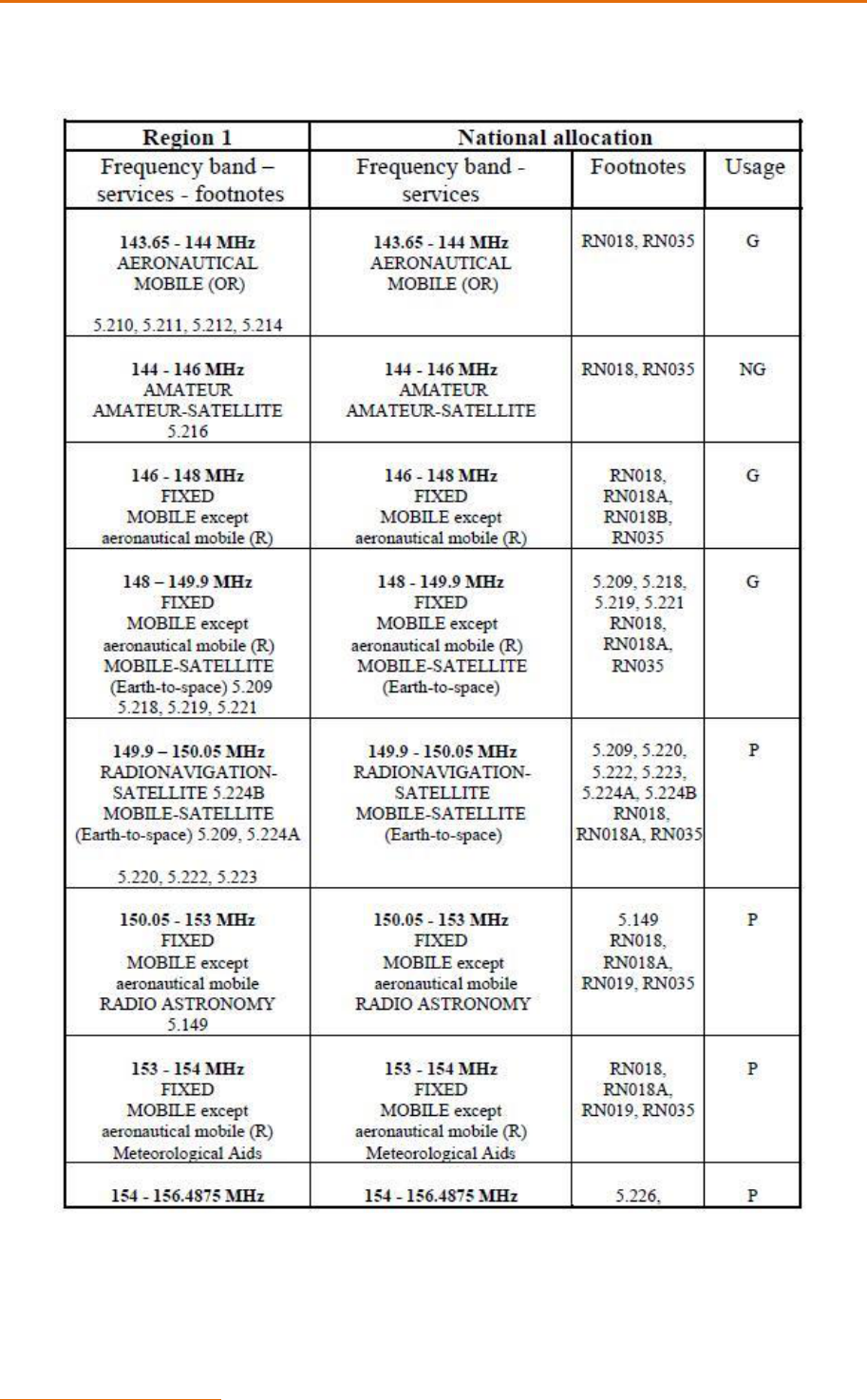
Guidelines for the preparation of a National Table of Frequency Allocations (NTFA)
30
Gestion du spectre
radioélectrique au Niger
A5.1: Examples of a National Frequency Allocation Table: Moldova
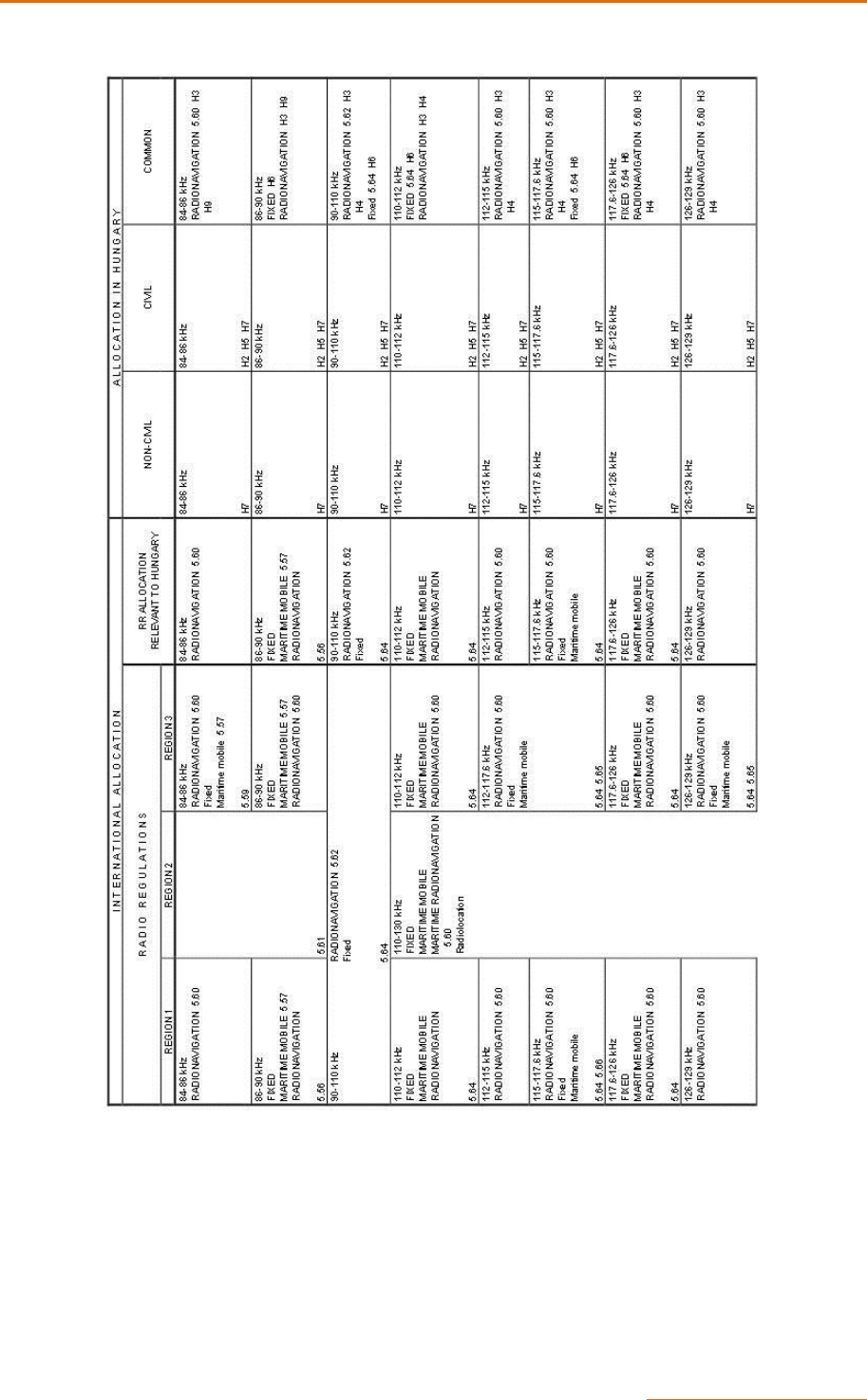
Guidelines for the preparation of a National Table of Frequency Allocations (NTFA)
31
A5.2: Examples of a National Frequency Allocation Table: Hungary
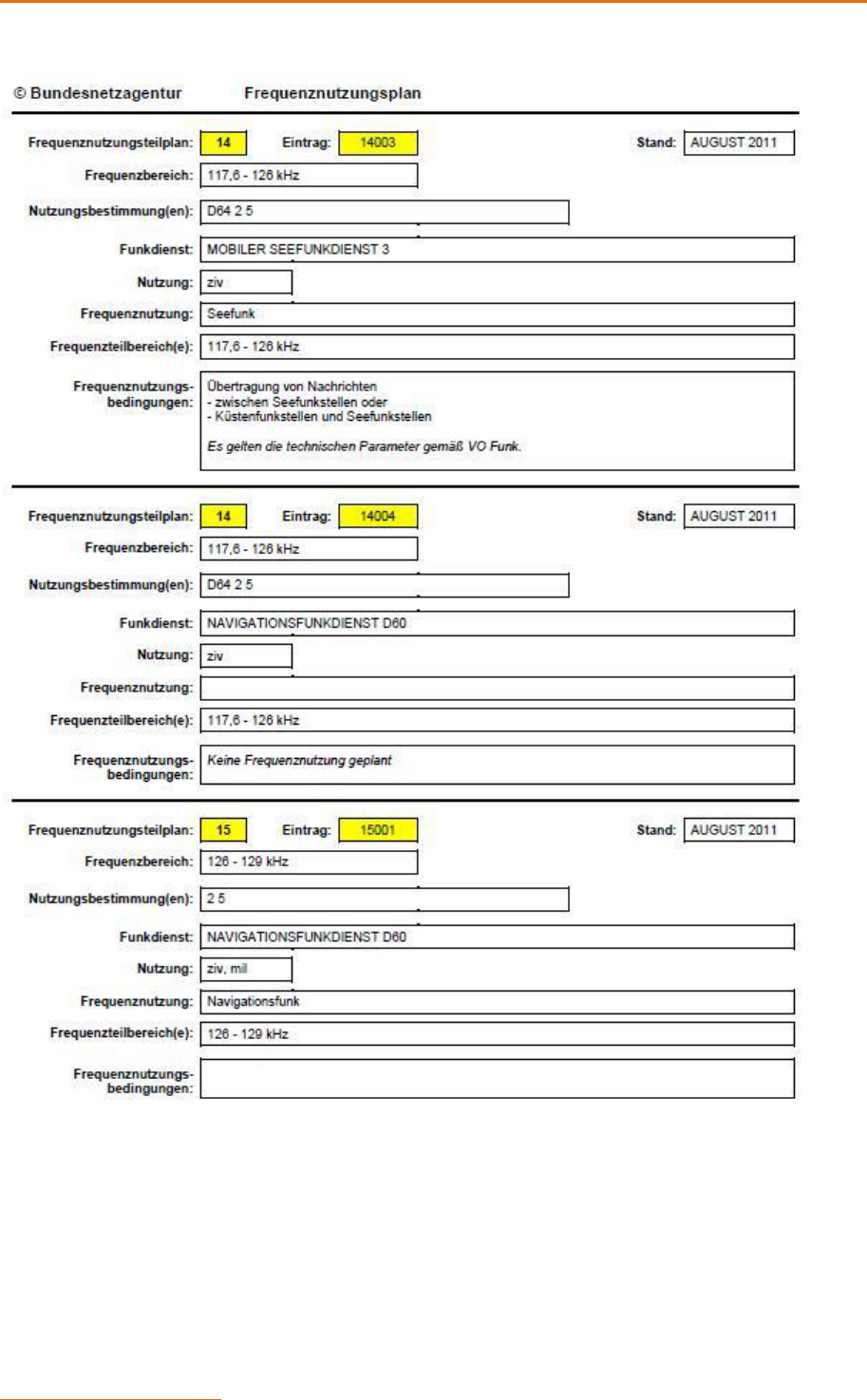
Guidelines for the preparation of a National Table of Frequency Allocations (NTFA)
32
Gestion du spectre
radioélectrique au Niger
A5.3: Examples of a National Table of Frequency Allocations: Germany
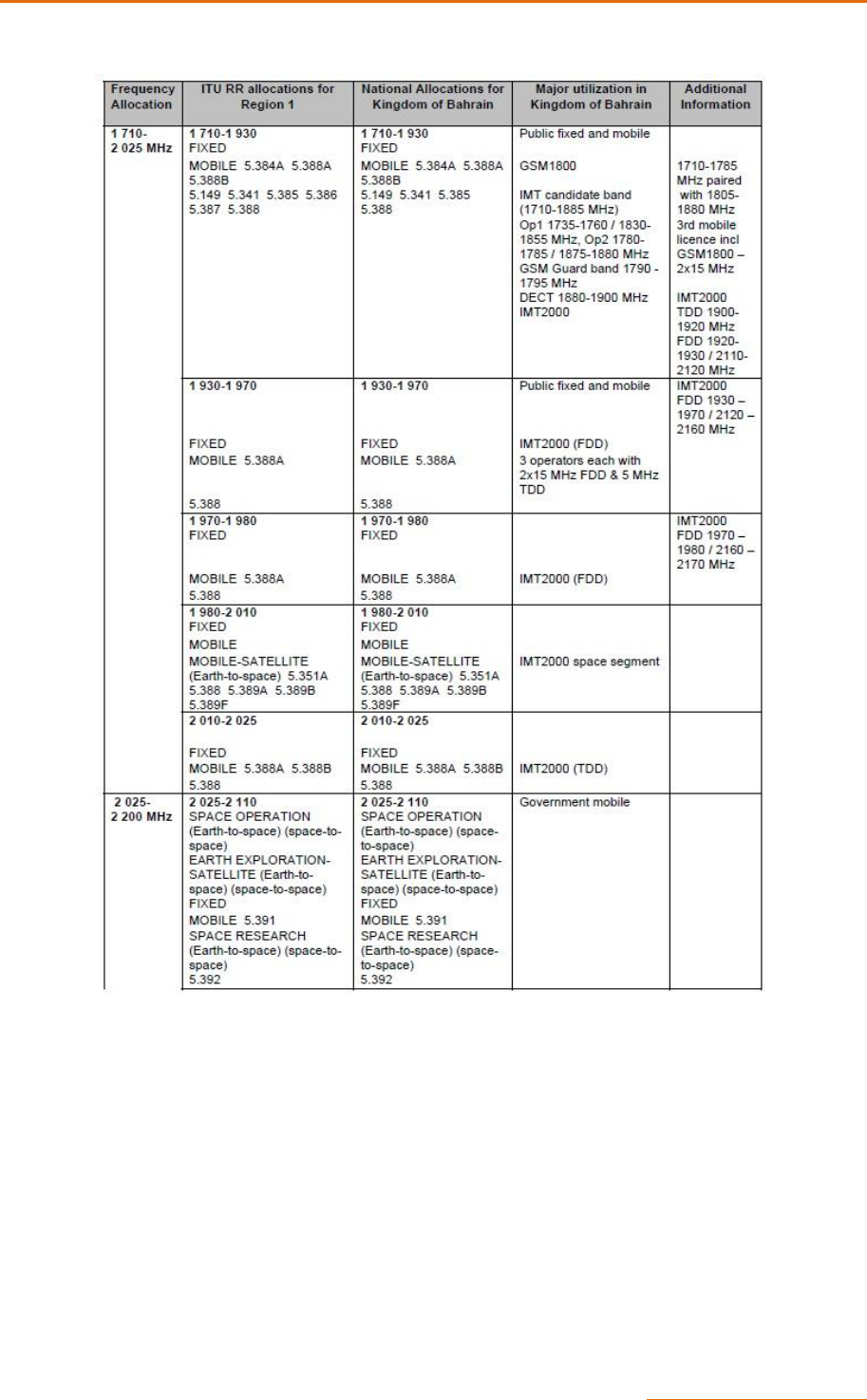
Guidelines for the preparation of a National Table of Frequency Allocations (NTFA)
33
A5.4: Examples of National Table of Frequency Allocations: Kingdom of Bahrain
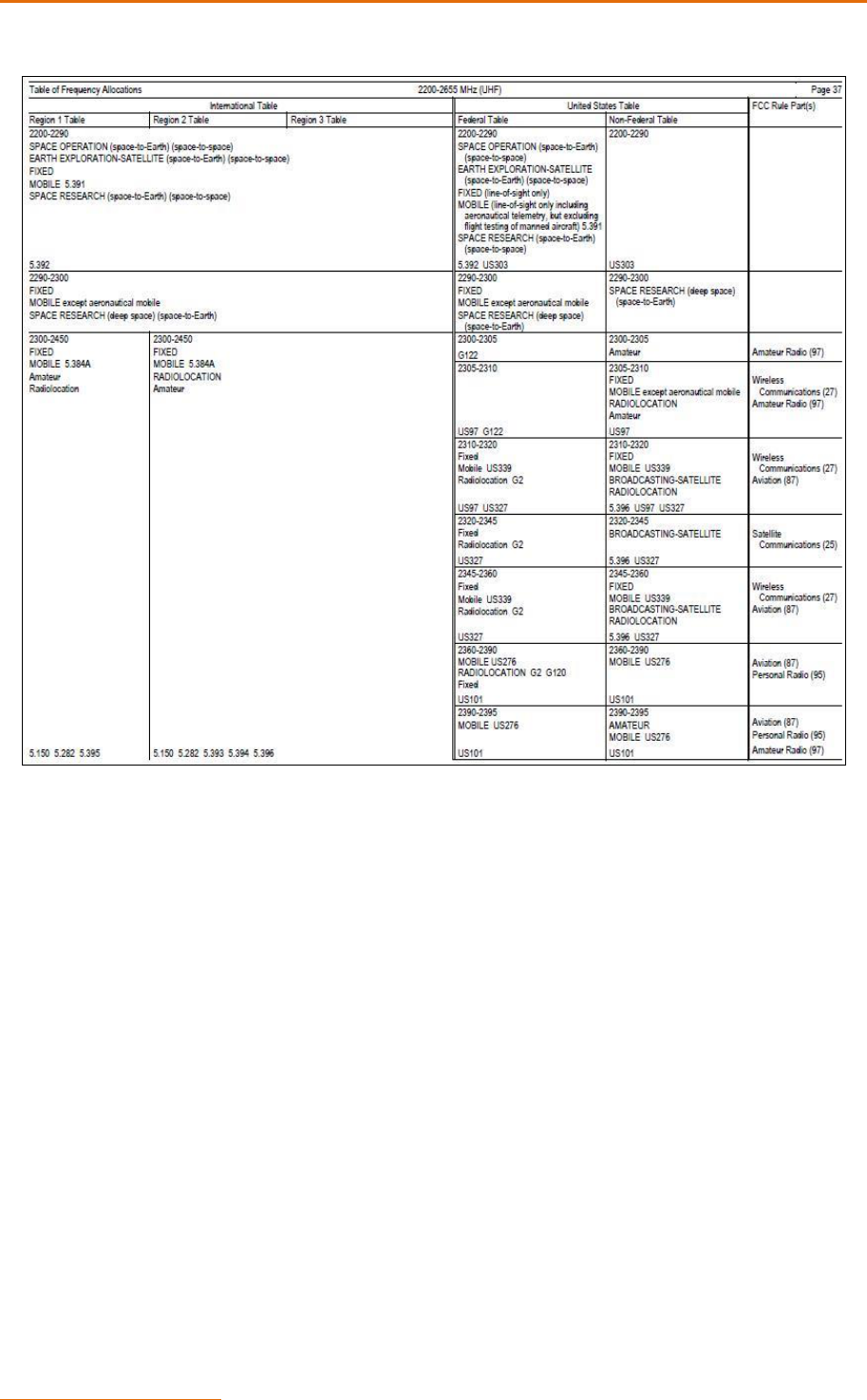
Guidelines for the preparation of a National Table of Frequency Allocations (NTFA)
34
Gestion du spectre
radioélectrique au Niger
A5.5: Examples of a National Table of Frequency Allocations: USA

Guidelines for the preparation of a National Table of Frequency Allocations (NTFA)
35
A5.6: Example of a graphical presentation of NTFA: USA

Guidelines for the preparation of a National Table of Frequency Allocations (NTFA)
36
Gestion du spectre
radioélectrique au Niger
A5.7: Frequency allocation chart facility in SMS4DC
10
10
ITU Spectrum Management System for Developing Countries (SMS4DC)

Guidelines for the preparation of a National Table of Frequency Allocations (NTFA)
37
Annex 6: Examples of national footnotes
These examples have been chosen to demonstrate the wide range of information that can be given by the
use of national footnotes.
A6.1: Canada
C36 (CAN-00) In the bands 1 990-2 025 MHz and 2 160-2 200 MHz, a moratorium has been placed on the
licensing of new systems in the fixed service. Existing fixed service systems operating in
these bands will have priority over the mobile-satellite service until January 1, 2003. After
this date, specific fixed service stations will be displaced, according to the transition policy,
to enable the implementation of mobile-satellite service systems in certain sub-bands. The
earliest mandatory date for fixed service frequency assignments that may be subject to
displacement will be January 1, 2003.
C38A (CAN-04) The use of the band 2 500-2 690 MHz by the mobile service is subject to future spectrum
policy and licensing considerations.
C39A (CAN-05) The band 5 725-5 825 MHz is designated for use by licence-exempt wireless local area
networks and devices with established maximum power levels and based upon not
interfering with, or claiming protection from, licensed services.
A6.2: Kingdom of Bahrain
BHR8 In the longer term VORs will be decommissioned in this band, after which the band will be
exclusively allocated to the aeronautical mobile service.
BHR9 In the medium term 8.33 KHz channel spacing in the band 117.975-137 MHz may be
introduced in accordance with regional plans developed under the auspices of the
International Civil Aviation Organization (ICAO).
BHR11 The band 450 - 470 MHz is a candidate band for a variety of modern mobile technologies
including GSM, TETRA, IS95, IMT as well as a residual band for analogue single and two
frequency conventional and trunked mobile networks. A strategy for the future use of this
band will be elaborated by the Spectrum Strategy and Coordination Committee (SSCC).
A6.3: Pakistan
PAK08 The frequency range 61-68 MHz can be considered for Terrestrial TV Broadcasting Service
PAK16 The frequency ranges 485-490/495-500 MHz and 806-811/851-856 MHz are identified for
Radio Trunking Services. Both 12.5 kHz and 25.0 kHz channel spacing will be considered on a
case by case basis.
A6.4: Thailand
T20 Channel arrangements of the bands 2025.5-2109.5 MHz and 2200.5-2284.5 MHz in the fixed
service are in accordance with Annex 1 to Recommendation ITU-R F.1098-1.
T21 Channel arrangements of the bands 2306-2387 MHz and 2400-2481 MHz in the fixed service
are in accordance with Annex 1 to Recommendation ITU-R F.746-3.
T22 Channel arrangements of the bands 2484.5-2568.5 MHz and 2603.5-2687.5 MHz in the fixed
service are in accordance with Recommendation ITU-R F.283-5 and their use is limited to
stations in upcountry area.
T23 The band 2504-2688 MHz in the fixed service is also designated for Multichannel Multipoint
Distribution Service (MMDS) application and limited to stations in Bangkok and suburb area.

Guidelines for the preparation of a National Table of Frequency Allocations (NTFA)
38
Gestion du spectre
radioélectrique au Niger
A6.5: Vietnam
VTN6A The band 450-470 MHz is identified for International Mobile Telecommunication (IMT)
systems.
VTN7 The bands 453.08-457.37 MHz and 463.08-467.37 MHz are reserved for the land mobile
communication system employing CDMA (Code Division Multiple Access) technology. If
necessary, the Administration shall specify these bands in detail plans of frequency.
VTN7A The bands 470-485 MHz and 610-698 MHz are priority used for the Broadcasting and Fixed
service, the band 585-610 MHz is priority used for Broadcasting service. Television digitalized
is encouraged.
A6.6: Great Britain
UK1 Except by special agreement having the approval of the National Frequency Planning Group
[a UK Cabinet Office Committee] this frequency band, or the allocation to this radio service, is
reserved exclusively for CIVIL use in accordance with 'Allocation to Services' [The NTFA gives
additional information in an explanatory note].
UK2 Except by special agreement having the approval of the NFPG this frequency band, or the
allocation to this radio service, is reserved exclusively for MILITARY use in accordance with the
'Allocation to Services' (The NTFA gives additional information in an explanatory note).
UK3 Responsibility for assigning frequencies in this band in accordance with the Allocation to
Services rests with Ofcom and the Scottish Government for emergency services (The NTFA
gives additional information in an explanatory note).
UK8 Details of the Memoranda of Understanding (MoUs) and Agreements entered into by Ofcom
relating to cross-border radio frequency coordination and the management of interference
are contained at [Annex K]
UK9 The Ministry of Defence requires at times to activate stations of the land mobile service,
employing low power for voice communications, in the range 1.5-30.0 MHz. Temporary
assignments will be negotiated directly with Ofcom and the Departments concerned or likely
to be affected. In certain bands however this general but qualified agreement to MILITARY
out-of-band usage cannot be permitted. These bands are annotated UK9.
UK11 Specific details of frequency bands available for low power devices exempt from licensing are
contained in Annex B. Please note that in addition to this footnote Ultra wide-band (UWB)
equipment is also authorised to transmit in most frequency bands, as mandated by European
Commission Decisions 2007/131/EC and 2009/343/EC. Due to the wide-band nature of the
devices they permitted to operate across most frequency bands and for this reason we have
not included them in the footnotes.

Guidelines for the preparation of a National Table of Frequency Allocations (NTFA)
39
Annex 7: Examples of regional cooperation in Frequency Allocation Tables
A7-1 Inter-American Telecommunication Commission (CITEL) provides an on-line searchable database of
allocations of the members of the Organisation of American States.
A7-2 Eastern Caribbean Telecommunications Authority (ECTEL) five Eastern Caribbean states
(Commonwealth of Dominica, Grenada, Saint Christopher and Nevis, Saint Lucia, Saint Vincent and The
Grenadines) provides an on-line searchable database of allocations of the members of ECTEL
A7-3 European Conference of Postal and Telecommunications Administrations (CEPT)
CEPT was established in 1959 and now has 48 member countries. The CEPT Electronic Communications
Committee (ECC) considers and develops policies on electronic communications activities in European
context, taking account of European and international legislations and regulations. The CEPT European
Communications Office (ECO) provides advice and support to CEPT to help it to develop and deliver its
policies and decisions in an effective and transparent way. The ECC has agreed ERC Report 25: the European
Common Frequency Allocation Table (ECA)
11
. The ECO provides the ECO Frequency Information System
(EFIS)
12
, an on-line searchable database on the harmonised availability of information regarding spectrum
use in Europe (/) by providing a single portal to access to the NTFAs of member countries.
11
ECC Report 25: www.erodocdb.dk/Docs/doc98/official/pdf/ERCREP025.PDF
12
EFIS: www.efis.dk/
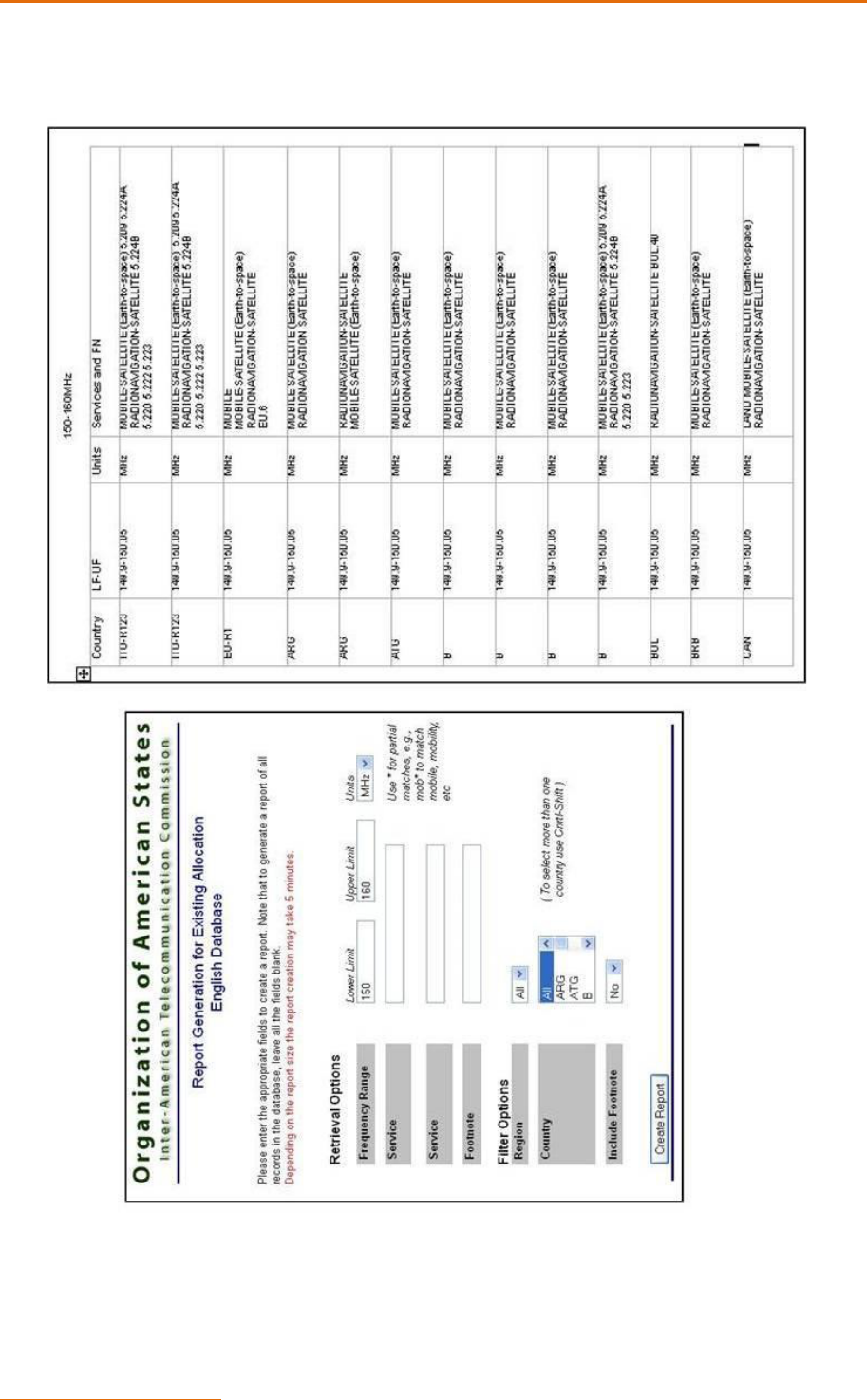
Guidelines for the preparation of a National Table of Frequency Allocations (NTFA)
40
Gestion du spectre
radioélectrique au Niger
A7.1: Example of regional cooperation in allocation tables
Inter-American Telecommunication Commission (CITEL)
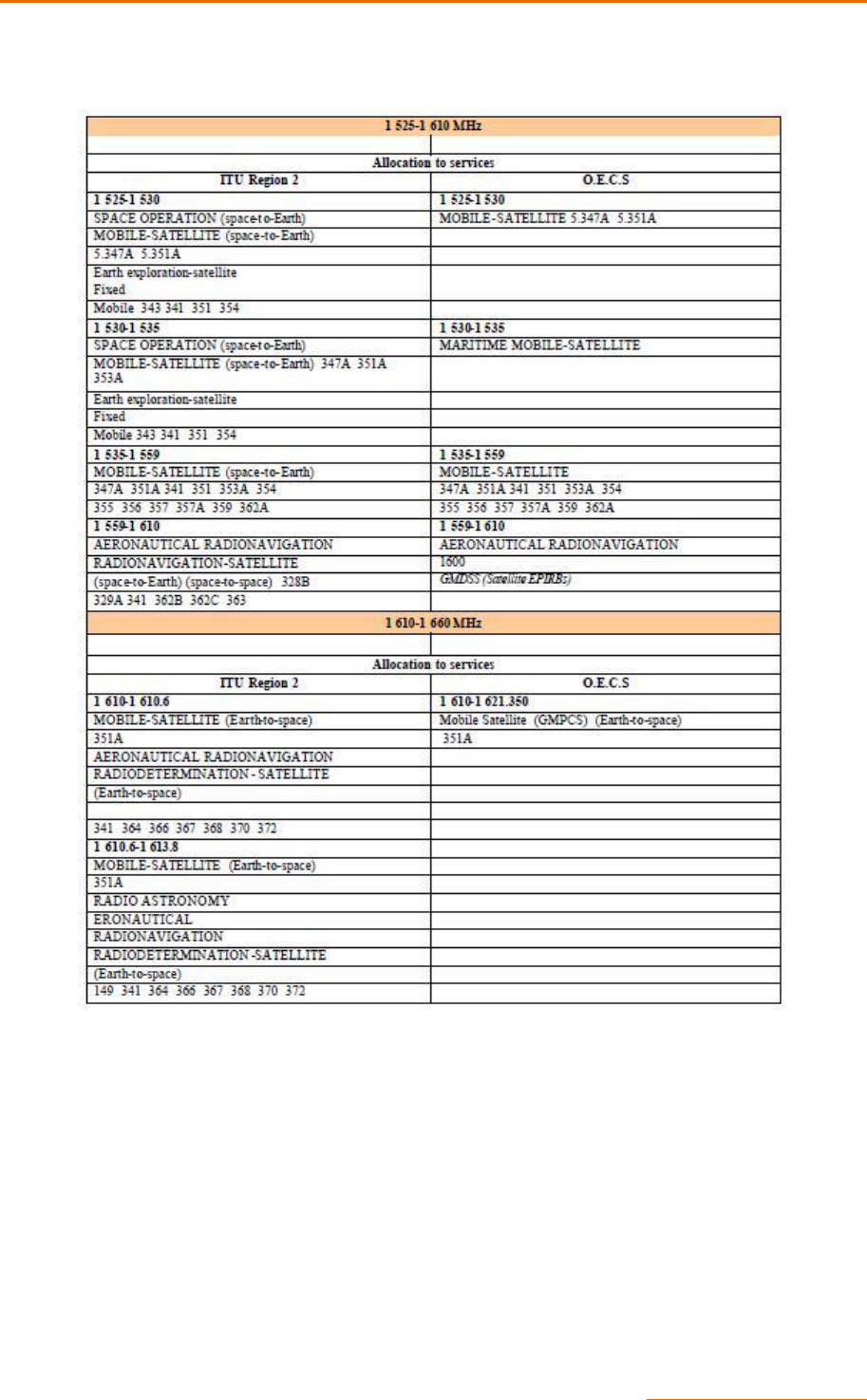
Guidelines for the preparation of a National Table of Frequency Allocations (NTFA)
41
A7.2: Example of regional cooperation in allocation tables
Eastern Caribbean Telecommunications Authority (ECTEL)
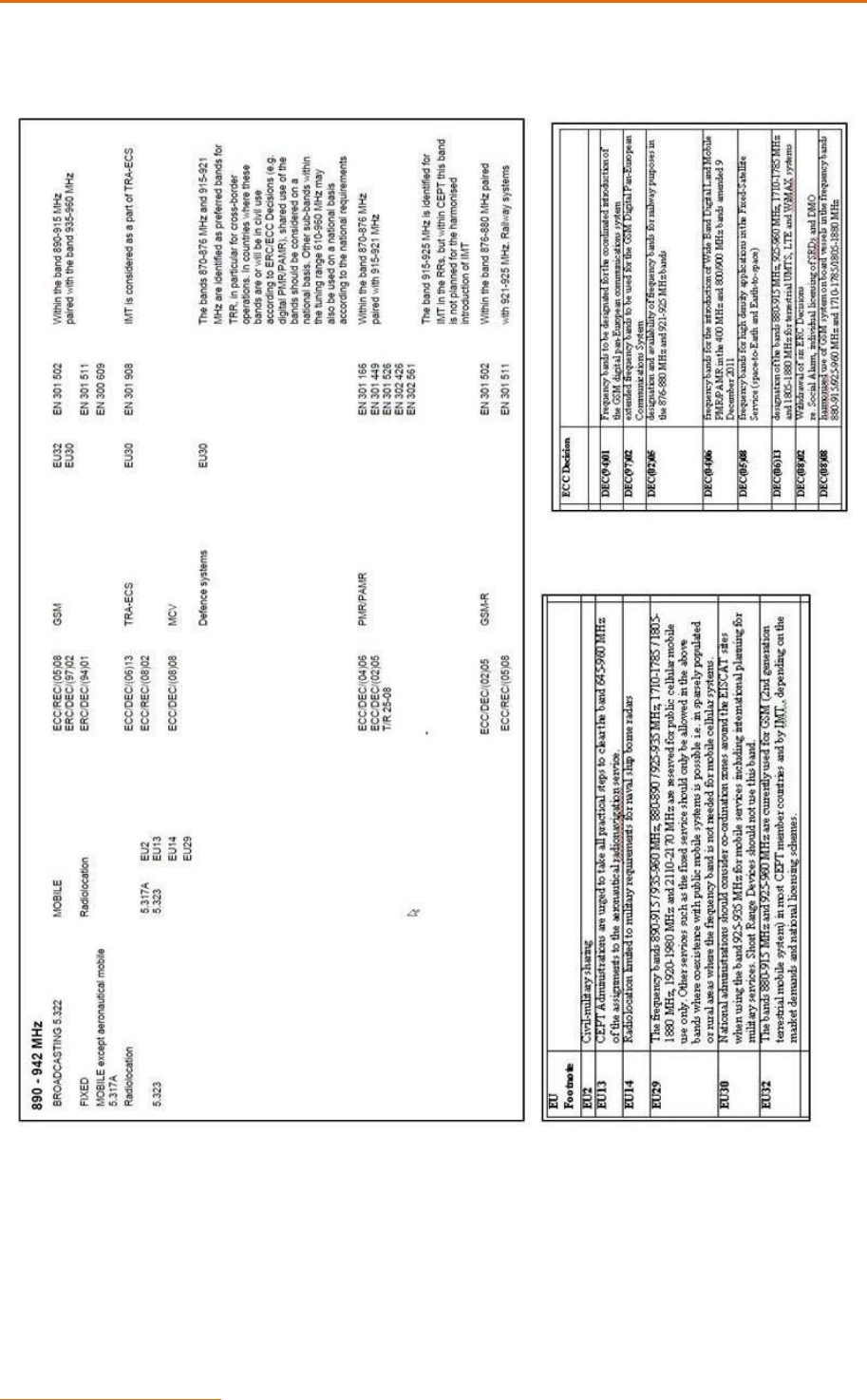
Guidelines for the preparation of a National Table of Frequency Allocations (NTFA)
42
Gestion du spectre
radioélectrique au Niger
A7.3: Example of regional cooperation in allocation tables
European Conference of Postal and Telecommunications Administrations (CEPT)
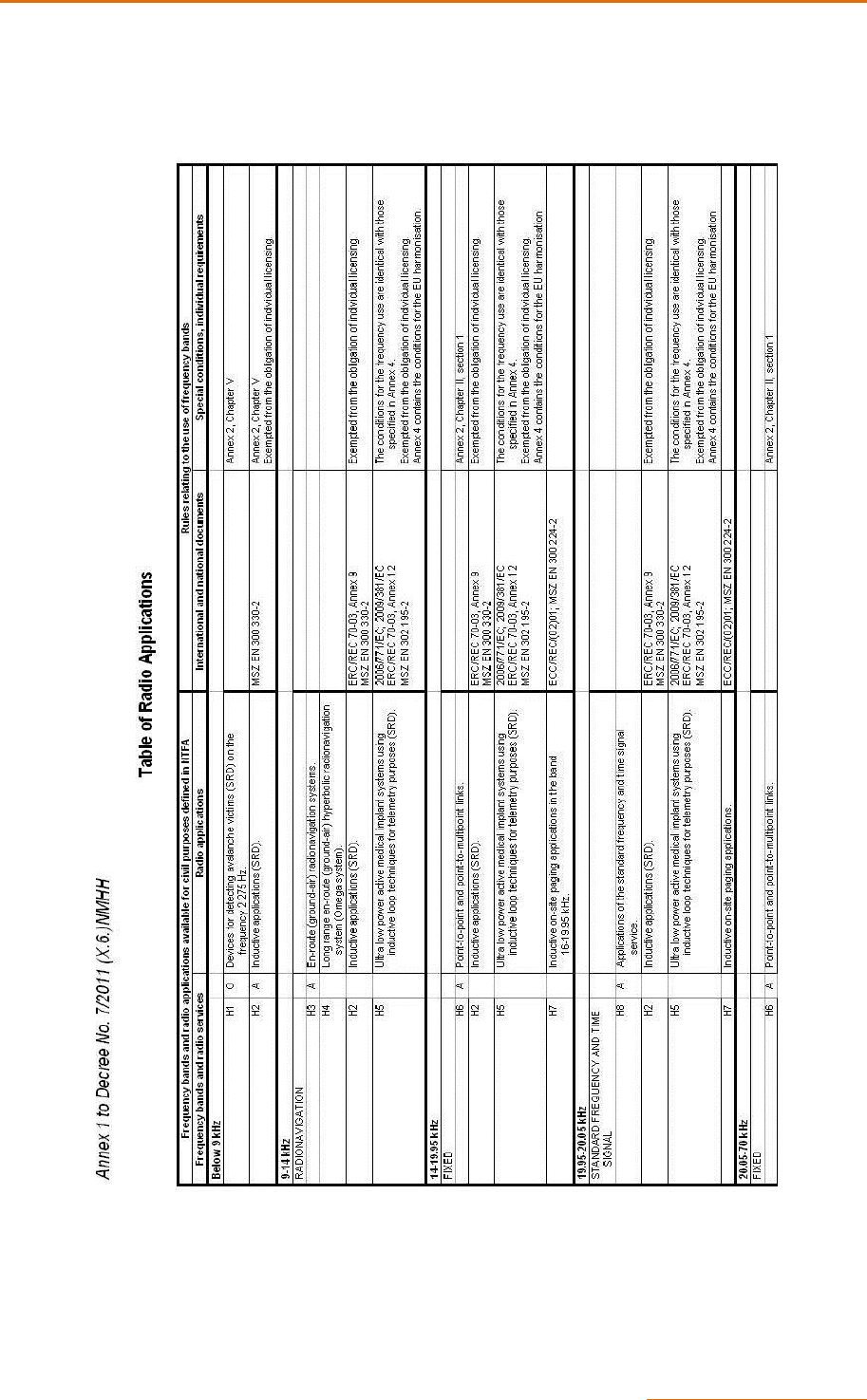
Guidelines for the preparation of a National Table of Frequency Allocations (NTFA)
43
Annex 8: Examples of tables of frequency use
A8.1: National tables of frequency use: Hungary (This example is completely separate from the NTFA but
each use is a reference from the NTFA)
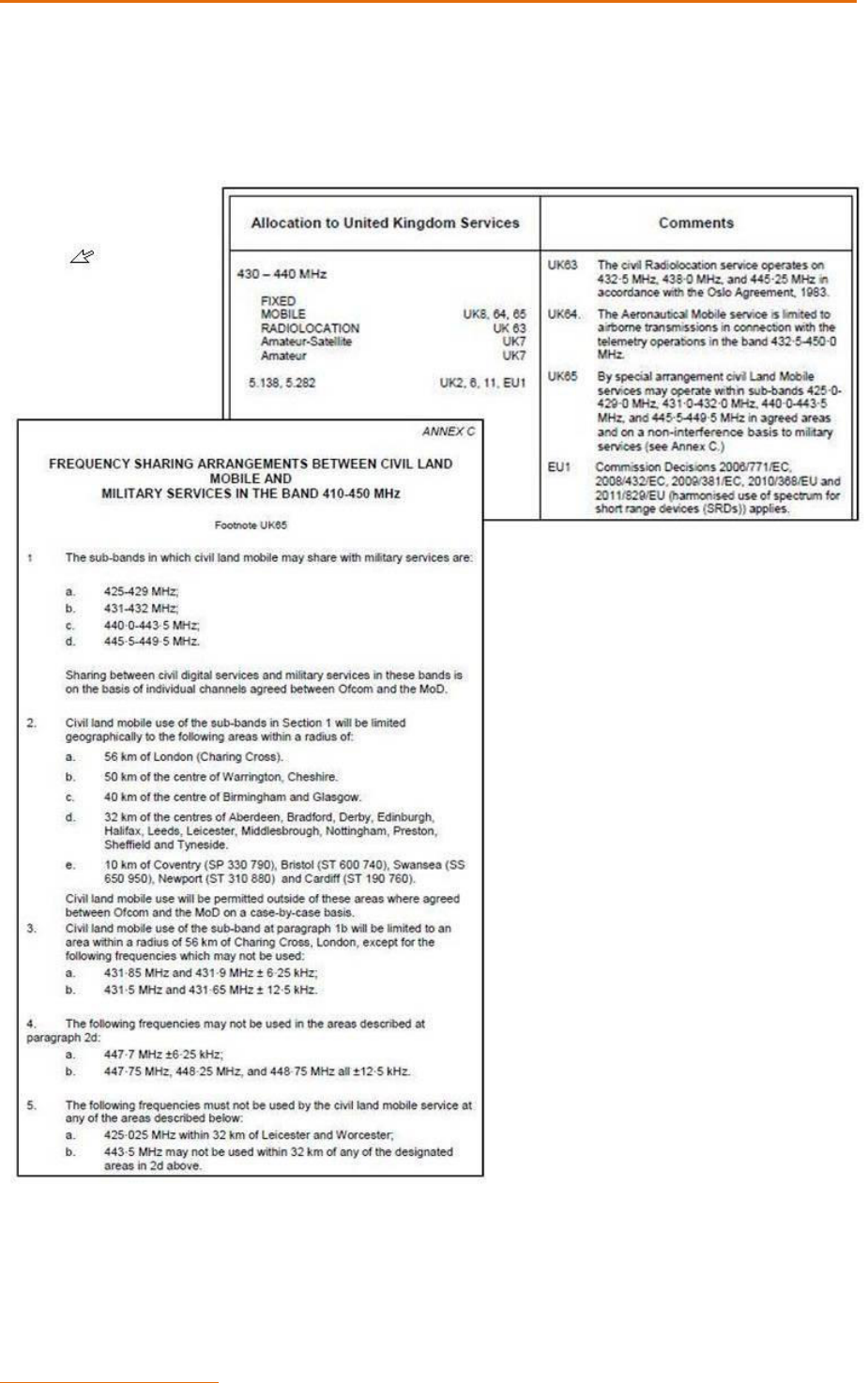
Guidelines for the preparation of a National Table of Frequency Allocations (NTFA)
44
Gestion du spectre
radioélectrique au Niger
A8.2: National table of frequency use: United Kingdom
The UK national table of frequency use is combined with the NTFA by providing frequency use information
in a set of detailed annexes and footnotes. This example shows information on applications in the
comments column with a reference to an annex giving detailed frequency (and geographical) sharing
arrangements between civil and military users.

Guidelines for the preparation of a National Table of Frequency Allocations (NTFA)
45
A8.3: National table of frequency use: Harmonized template for national radio interface specifications
used by European countries
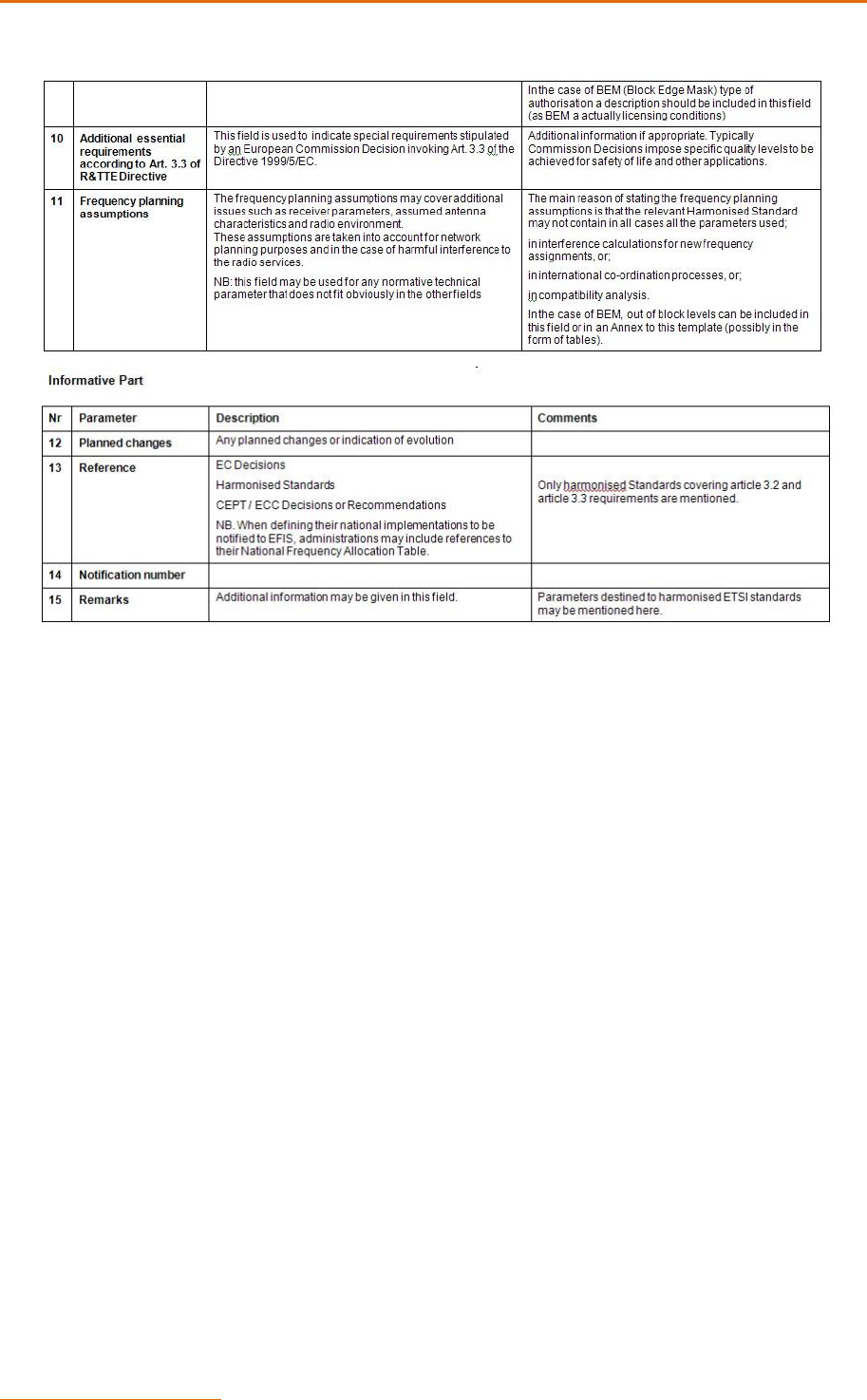
Guidelines for the preparation of a National Table of Frequency Allocations (NTFA)
46
Gestion du spectre
radioélectrique au Niger
A8.3: (continued)

Guidelines for the preparation of a National Table of Frequency Allocations (NTFA)
47
A8.4: Example of frequency band and channelling arrangements: European countries
The frequency band and channelling arrangements for the land mobile service in frequency bands between
30-960 MHz are contained in recommendation T/R 25-08 developed within the CEPT framework. The CEPT
has developed various recommended channel arrangements for fixed and mobile services.
Key to symbols:
ARN Aeronautical radionavigation (ILS/Marker beacons)
Du Duplex operation
FB Base station
ML Mobile station
Si Simplex operation
App 18 Use in accordance with RR Appendix 18 "Table of Transmitting Frequencies in the VHF Maritime Mobile Band"
Si
ML
1
FB
1
ML
2
ML
3
Si
FB
2
Si
FB
3
54
29.7
54
68
87.5
85.0
84.6
77.8
77.7
7 MHz
Du
A
R
N
50
MHz
80
MHz
61
68
9.8 MHz
Du
60
MHz
Si
ML
1
Si
68
ML
2
FB
1
Si
FB
2
App
18
ML
3
App
18
Si
App
18
85.0
FB
3
Si
ML
4
Si
FB
4
160
MHz
146
146.8
149.9
150.05
151.4
154.5
154.65
156
157.45
160.6
162.05
165.2
169.4
174
4.6 MHz
Du
Si
FB
1
ML
1
ML
2
FB
2
FB
3
ML
3
Si
200
MHz
8 MHz
Du
174
175.5
183.5
191.5
199.5
207.5
215.5
223.5
230
ML
1
ML
2
Si
FB
1
FB
2
390
MHz
10 MHz
Du
380
385
389.9
390
395
399.9
Si
ML
FB
Si
ML
1
FB
1
420
MHz
460
MHz
10 MHz
Du
10 MHz
Du
406.1
410
420
430
440
450
460
470
Si
ML
FB
900
MHz
45 MHz
Du
862
870
876
921
160.975
161.475
165.225
169.825
74.8
75.2
915

Guidelines for the preparation of a National Table of Frequency Allocations (NTFA)
48
Gestion du spectre
radioélectrique au Niger
A8.5: Example of frequency band and channelling arrangements: Australia
The Australian Communications and Media Authority plans for frequency bands are available from:
www.acma.gov.au/Industry/Spectrum/Spectrum-planning/About-spectrum-planning/band-plans-
spectrum-planning-acma.
The plans provide a detailed text description with exact frequency limits and also present the information
in a diagram format.
The example diagrams below are for the 148-174 MHz and 820-960 MHz bands:

Guidelines for the preparation of a National Table of Frequency Allocations (NTFA)
49
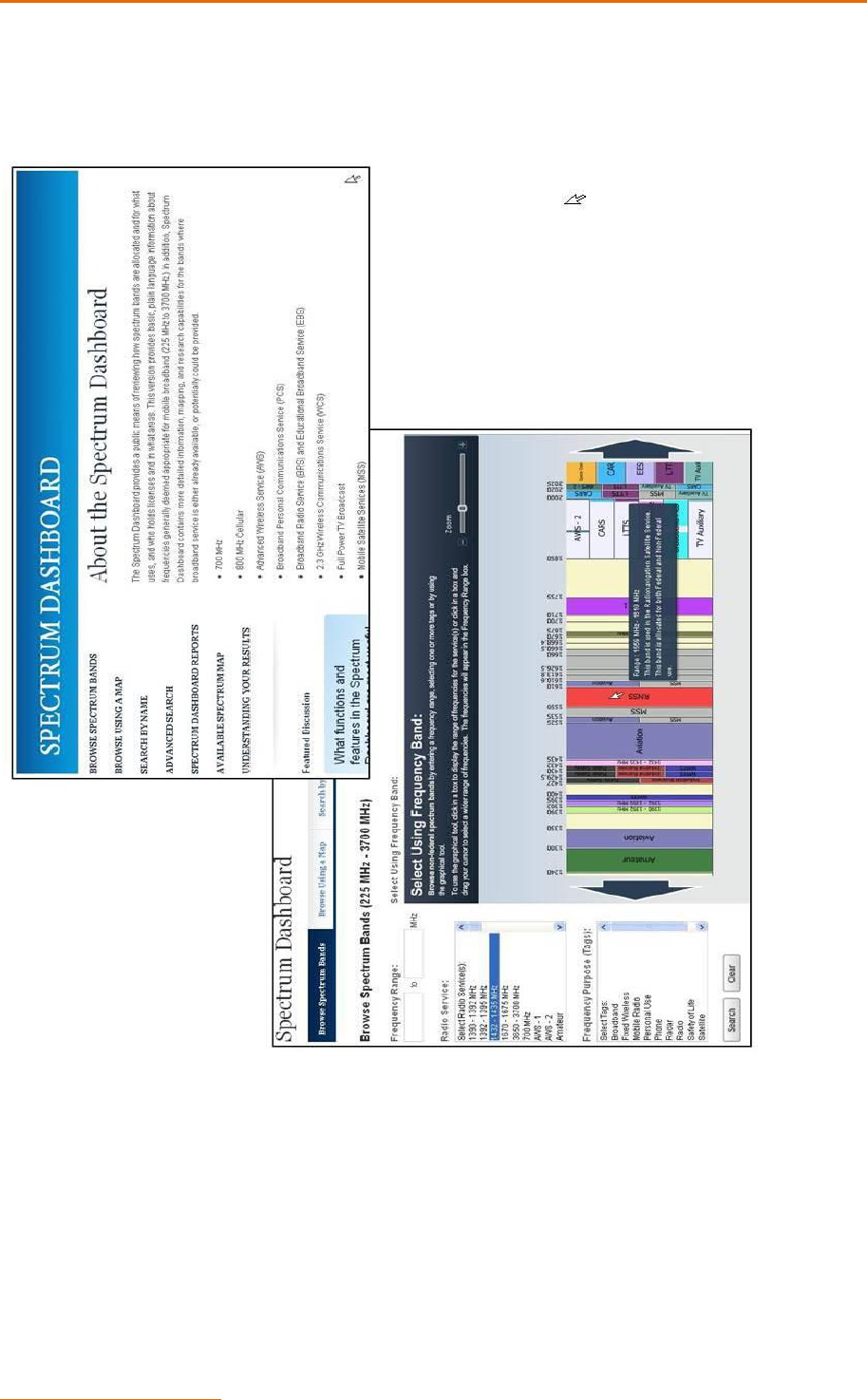
Guidelines for the preparation of a National Table of Frequency Allocations (NTFA)
50
Gestion du spectre
radioélectrique au Niger
Annex 9: Examples of on-line access to frequency allocation and use
information
A9.1: USA
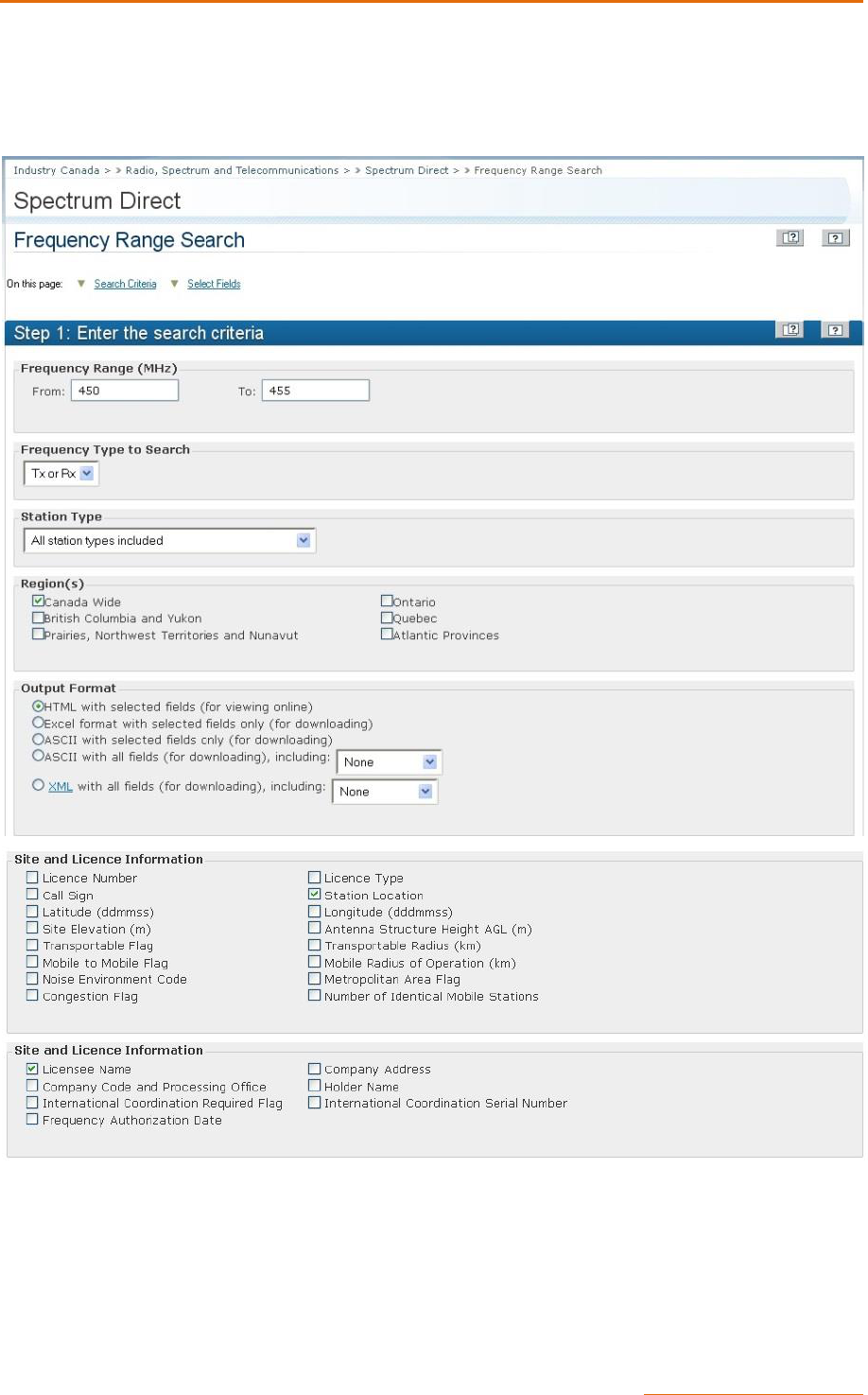
Guidelines for the preparation of a National Table of Frequency Allocations (NTFA)
51
A9.2: Canada
Industry Canada provides a detailed on-line search facility for the national frequency database through the
Spectrum Direct system

Guidelines for the preparation of a National Table of Frequency Allocations (NTFA)
52
Gestion du spectre
radioélectrique au Niger
Annex 10: Example of obtaining information on national spectrum use from
operators: Nigeria
The following text is an example of a national exercise to collect spectrum usage information to improve
spectrum management by requesting existing users to complete a “template” specifying details of use.
As part of continuing efforts to provide efficient management of the radio frequency spectrum in Nigeria,
the Commission is putting in place a modern Spectrum Management and Monitoring System (SMMS). As
part of the SMMS implementation, detailed information is required about current and continuing
utilisation of frequencies assigned to telecommunications operators, equipment operating on those
frequencies and sites/locations where they are deployed, etc. The information is required for creating a
database on the utilization of frequencies and associated information that will be constantly updated.
The records will provide an invaluable resource for:
• Facilitating resolution of interference
• Spectrum planning, policy; and
• The overall spectrum management strategy of the Commission.
All telecommunications operators are accordingly required to furnish the relevant information to the
Commission according to the prescribed format and also update the same periodically as specified by the
Commission.
Telecommunications operators are requested to download the following Spectrum Utilisation Reporting
Templates (MS Excel) where relevant and fill in the required data and thereafter forward the completed
forms via email to [the administration].
• Base Station Data Gathering Template (33.5 kB) – This is to collate Base Station Data from all
telecommunications operators.
• Deployed Microwave Links Reporting Template (399 kB) – This is for all operators of
telecommunications systems or networks, public or private, that have deployed microwave links.
Operators are required to file subsequent updates of the deployed microwave hops on the 1st of
April, August and December. The updates should include previous submissions in black font,
indications of deleted links in red, added links in blue and/or links with parameters modified in
purple.
• Licence Exempt Spectrum Reporting Template (20.73 kB) – This is for all users of License Exempt
frequency bands to register the spectrum in use by their operations.

Guidelines for the preparation of a National Table of Frequency Allocations (NTFA)
53
Annex 11: List of example administration web sites and URLS to access NTFA
Africa
Kenya: www.cck.go.ke/licensing/spectrum/freq_table.html
Nigeria: www.ncc.gov.ng/index.php?option=com_content&view=article&id=83&Itemid=97
Lesotho: www.lca.org.ls/images/documents/lesotho_national_frequency_allocation_plan.pdf
Mauritius: www.icta.mu/radiocommunication/frequencyplan.htm
Tanzania: www.egov.go.tz/home/pages/309
Uganda: www.ucc.co.ug/data/smenu/77/Spectrum.html
Arab States
Bahrain: www.tra.org.bh/EN/marketSpectrum.aspx
Jordan: www.trc.gov.jo/index.php?option=com_content&task=view&id=439&lang=english
Saudi Arabia: www.citc.gov.sa/English/RulesandSystems/Bylaws/Pages/default.aspx
Asia-Pacific Telecommunity (APT):
List of the web sites of APT member countries: www.apt.int/AFIS
Europe:
http://ec.europa.eu/enterprise/sectors/rtte/documents/additional-information/index_en.htm
North and South America
Organisation of American States spectrum information database:
http://oasforum.oas.org/citelituv3.nsf/ensearchform?openform
Canada: www.ic.gc.ca/eic/site/smt-gst.nsf/eng/h_sf01678.html
Mexico: www.cft.gob.mx:8080/portal/
Peru: www.mtc.gob.pe/portal/inicio.html

Guidelines for the preparation of a National Table of Frequency Allocations (NTFA)
54
Gestion du spectre
radioélectrique au Niger
Annex 12: Glossary of Abbreviations
This Glossary of Abbreviations is contained in the Hungary NTFA. It is included here as a useful example as
the majority of the abbreviations will be generally applicable. A more detailed database of terms and
definitions can be found out at: www.itu.int/online/termite/index.html
A/A Air-to-Air
ACAS Airborne Collision Avoidance System
AES Aircraft Earth Station
A/G/A Air-Ground-Air
AIS Universal Shipborne Automatic Identification System
AVI Automatic Vehicle Identification for Railways
BFWA Broadband Fixed Wireless Access
BWA Broadband Wireless Access
CEPT European Conference of Postal and Telecommunications Administrations
CGC Complementary Ground Component
CT1 Cordless Telephone 1
CT2 Cordless Telephone 2
DECT Digital European Cordless Telecommunications
DME Distance Measuring Equipment
DMO Direct Mode Operation
DSC Digital Selective Calling
DSRR Digital Short Range Radio
DVB-H Digital Video Broadcasting – Handheld
EC European Community
ECC Electronic Communications Committee
ECC/DEC ECC Decision
ECC/REC ECC Recommendation
EDR Unified Digital Radiocommunication System
EEC European Economic Community
EFIS ERO Frequency Information System
e.i.r.p. Equivalent Isotropically Radiated Power
EN European Standard
epfd Equivalent power flux-density
EPIRB Emergency Position-Indicating Radiobeacon
ERC European Radiocommunications Committee
ERC/DEC ERC Decision
ERC/REC ERC Recommendation
ERMES European Radio Messaging System

Guidelines for the preparation of a National Table of Frequency Allocations (NTFA)
55
ERO European Radiocommunications Office
ETCS European Train Control System
FM Frequency Modulation
GBSAR Ground Based Synthetic Aperture Radar
GMDSS Global Maritime Distress and Safety System
GMT Greenwich Mean Time
GNSS Global Navigation Satellite System
GSM Global System for Mobile Communications
GSM 1800 GSM in the 1800 MHz band
GSM-R GSM-Railway
HAPS High Altitude Platform Station
HDFSS High-density applications in the fixed-satellite service
HF High Frequency
ICAO International Civil Aviation Organization
ICAO Annex 10 Annex 10 to the Convention on International Civil Aviation (aeronautical
telecommunication)
ILS Instrument Landing System
ILS LOC Localizer Element of ILS
IMO International Maritime Organization
IMT-2000 International Mobile Telecommunications-2000
ISM Industrial, Scientific and Medical
ITS Intelligent Transport Systems
ITU International Telecommunication Union
ITU-R ITU Radiocommunication Sector
LF Low Frequency
Loran Long range air navigation system
LTE Long Term Evolution
MBS Mobile Broadband System
MCA Mobile Communication on Aircraft
MF Medium Frequency
MLS Microwave Landing System
MSI Maritime Safety Information
MVDS Multipoint Video Distribution System
MWS Multimedia Wireless System
NATO North Atlantic Treaty Organisation
NAVTEX Automated direct-printing telegraph system for navigational and meteorological
warnings and urgent information to ship

Guidelines for the preparation of a National Table of Frequency Allocations (NTFA)
56
Gestion du spectre
radioélectrique au Niger
NDB Non-Directional Radio Beacon
NGSO Non-Geostationary Orbit
NJFA NATO Joint Civil/Military Frequency Agreement
NTFA National Table of Frequency Allocations
(OR) Off-route
PAMR Public Access Mobile Radio
PMR Professional/Private Mobile Radio
PMR 446 Professional Mobile Radio 446
PR 27 Personal Radio 27
PSTN Public Switched Telecommunication Network
(R) Route
Rev.WRC-03 Revised by WRC-03
Rev.WRC-2000 Revised by WRC-2000
Rev.WRC-95 Revised by WRC-95
Rev.WRC-97 Revised by WRC-97
RFID Radio Frequency Identification
RLAN Radio Local Area Network
ROES Receive Only Earth Station
RR Radio Regulations
RTTT Road Transport & Traffic Telematics
SART Search and Rescue Transponder
S-DAB Satellite Digital Audio Broadcasting
SI System International of Units
SIT Satellite Interactive Terminal
SIT Shipborne Interrogator-Transponder
SNG Satellite News Gathering
S-PCS Satellite Personal Communications Services/Systems
SRD Short Range Device
SSB Single-Sideband
SSR Secondary Surveillance Radar
SUT Satellite User Terminal
TACAN Tactical Air Navigation System
T-DAB Terrestrial Digital Audio Broadcasting
TLPR Tank Level Probing Radar
TV Television
TVOR Terminal VOR
UHF Ultra High Frequency

Guidelines for the preparation of a National Table of Frequency Allocations (NTFA)
57
UIC International Union of Railways
UMTS Universal Mobile Telecommunications System
UNO United Nations Organization
UTC Coordinated Universal Time
UWB Ultra-Wideband
VHF Very High Frequency
VOR VHF Omnidirectional Radio Range
VSAT Very Small Aperture Terminal
WARC World Administrative Radio Conference
WARC-92 World Administrative Radio Conference for Dealing with Frequency Allocations in
Certain Parts of the Spectrum, Malaga-Torremolinos, 1992
WAS Wireless Access Systems
WiBro Wireless Broadband
WiMAX Worldwide Interoperability for Microwave Access
WRC World Radiocommunication Conference
WRC-03 World Radiocommunication Conference, Geneva, 2003
WRC-2000 World Radiocommunication Conference, Istanbul, 2000
WRC-95 World Radiocommunication Conference, Geneva, 1995
WRC-97 World Radiocommunication Conference, Geneva, 1997

International Telecommunication Union (ITU)
Telecommunication Development Bureau (BDT)
Office of the Director
Place des Nations
CH-1211 Geneva 20 – Switzerland
Email: bdtdirector@itu.int
Tel.: +41 22 730 5035/5435
Fax: +41 22 730 5484
Deputy to the Director and
Director,
Administration and
Operations Coordination
Department (DDR)
Infrastructure Enabling
Environmnent and
e-Applications Department (IEE)
Innovation and Partnership
Department (IP)
Project Support and Knowledge
Management Department (PKM)
Email: bdtdeputydir@itu.int Email: bdtiee@itu.int Email: bdtip@itu.int Email: bdtpkm@itu.int
Tel.: +41 22 730 5784 Tel.: +41 22 730 5421 Tel.: +41 22 730 5900 Tel.: +41 22 730 5447
Fax: +41 22 730 5484 Fax: +41 22 730 5484 Fax: +41 22 730 5484 Fax: +41 22 730 5484
Africa
Ethiopia Cameroon Senegal Zimbabwe
International Telecommunication
Union (ITU)
Regional Office
P.O. Box 60 005
Gambia Rd., Leghar ETC Building
3rd floor
Addis Ababa – Ethiopia
Union internationale des
télécommunications (UIT)
Bureau de zone
Immeuble CAMPOST, 3
e
étage
Boulevard du 20 mai
Boîte postale 11017
Yaoundé – Cameroon
Union internationale des
télécommunications (UIT)
Bureau de zone
19, Rue Parchappe x Amadou
Assane Ndoye
Immeuble Fayçal, 4
e
étage
B.P. 50202 Dakar RP
Dakar – Senegal
International Telecommunication
Union (ITU)
Area Office
TelOne Centre for Learning
Corner Samora Machel and
Hampton Road
P.O. Box BE 792 Belvedere
Harare – Zimbabwe
Email: itu-addis@itu.int Email: itu-yaounde@itu.int Email: itu-dakar@itu.int Email: itu-harare@itu.int
Tel.: +251 11 551 4977 Tel.: + 237 22 22 9292 Tel.: +221 33 849 7720 Tel.: +263 4 77 5939
Tel.: +251 11 551 4855 Tel.: + 237 22 22 9291 Fax: +221 33 822 8013 Tel.: +263 4 77 5941
Tel.: +251 11 551 8328 Fax: + 237 22 22 9297 Fax: +263 4 77 1257
Fax: +251 11 551 7299
Americas
Brazil Barbados Chile Honduras
União Internacional de
Telecomunicações (UIT)
Regional Office
SAUS Quadra 06, Bloco “E”
11º andar, Ala Sul
Ed. Luis Eduardo Magalhães (Anatel)
70070-940 Brasilia, DF – Brazil
International Telecommunication
Union (ITU)
Area Office
United Nations House
Marine Gardens
Hastings, Christ Church
P.O. Box 1047
Bridgetown – Barbados
Unión Internacional de
Telecomunicaciones (UIT)
Oficina de Representación de Área
Merced 753, Piso 4
Casilla 50484, Plaza de Armas
Santiago de Chile – Chile
Unión Internacional de
Telecomunicaciones (UIT)
Oficina de Representación de Área
Colonia Palmira, Avenida Brasil
Ed. COMTELCA/UIT, 4.º piso
P.O. Box 976
Tegucigalpa
– Honduras
Email: itubrasilia@itu.int Email: itubridgetown@itu.int Email: itusantiago@itu.int Email: itutegucigalpa@itu.int
Tel.: +55 61 2312 2730-1 Tel.: +1 246 431 0343/4 Tel.: +56 2 632 6134/6147 Tel.: +504 22 201 074
Tel.:
+55 61 2312 2733-5 Fax: +1 246 437 7403 Fax: +56 2 632 6154 Fax: +504 22 201 075
Fax: +55 61 2312 2738
Arab States Asia and the Pacific CIS countries
Egypt Thailand Indonesia Russian Federation
International Telecommunication
Union (ITU)
Regional Office
Smart Village, Building B 147, 3rd floor
Km 28 Cairo – Alexandria Desert Road
Giza Governorate
Cairo – Egypt
International Telecommunication
Union (ITU)
Regional Office
Thailand Post Training Center, 5th
floor,
111 Chaengwattana Road, Laksi
Bangkok 10210 – Thailand
Mailing address
P.O. Box 178, Laksi Post Office
Laksi, Bangkok 10210 – Thailand
International Telecommunication
Union (ITU)
Area Office
Sapta Pesona Building, 13th floor
JI. Merdan Merdeka Barat No. 17
Jakarta 10001 – Indonesia
Mailing address:
c/o UNDP – P.O. Box 2338
Jakarta 10001 – Indonesia
International Telecommunication
Union (ITU)
Area Office
4, Building 1
Sergiy Radonezhsky Str.
Moscow 105120
Russian Federation
Mailing address:
P.O. Box 25 – Moscow 105120
Russian Federation
Email: itucairo@itu.int Email: itubangkok@itu.int Email: itujakarta@itu.int Email: itumoskow@itu.int
Tel.: +202 3537 1777 Tel.: +66 2 575 0055 Tel.: +62 21 381 3572 Tel.: +7 495 926 6070
Fax: +202 3537 1888 Fax: +66 2 575 3507 Tel.: +62 21 380 2322 Fax: +7 495 926 6073
Tel.: +62 21 380 2324
Fax: +62 21 389 05521
Europe
Switzerland
International Telecommunication
Union (ITU)
Telecommunication Development
Bureau (BDT)
Europe Unit (EUR)
Place des Nations
CH-1211 Geneva 20 – Switzerland
Switzerland
Email: eurregion@itu.int
Tel.: +41 22 730 5111

Printed in Switzerland
Geneva, 2015
07/2015
Guidelines for the preparation of a
NATIONAL TABLE OF
FREQUENCY ALLOCATIONS
(NTFA)
INFRASTRUCTURE
International Telecommunication Union
Telecommunication Development Bureau
Place des Nations
CH-1211 Geneva 20
Switzerland
www.itu.int
GUIDELINES FOR THE PREPARATION OF A NATIONAL TABLE OF FREQUENCY ALLOCATIONS (NTFA)
Telecommunication Development Sector
ISBN 978-92-61-15591-9
9 7 8 9 2 6 1 1 5 5 9 1 9
